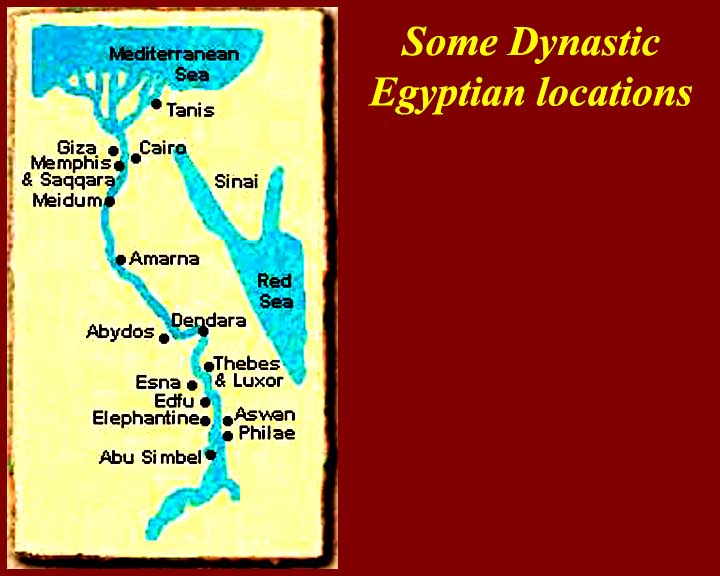
http://www.mmdtkw.org/EGtkw0200a.jpg
Ancient Egypt developed along the Nile River, although there were some smaller inhabited areas along the Red Sea and at Western Desert oases.
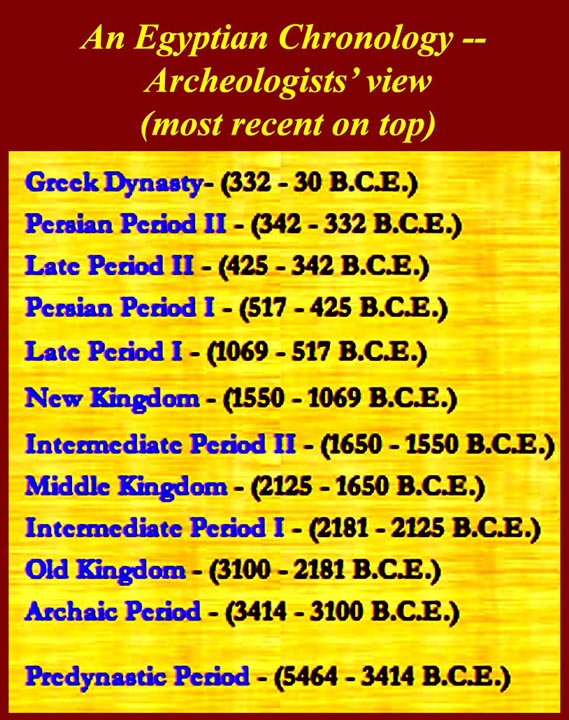
http://www.mmdtkw.org/EGtkw0200bArcheologistChron.jpg
Archeologists work from the top down, uncovering more recent layers first. Due to over-building, re-use, and intentional and unintentional destruction, we often have much better information on the top -- more recent -- levels. To understand what has happened, we get to the bottom and then reverse direction, explaining the History from the earliest to the latest -- like the Biblical "begats".
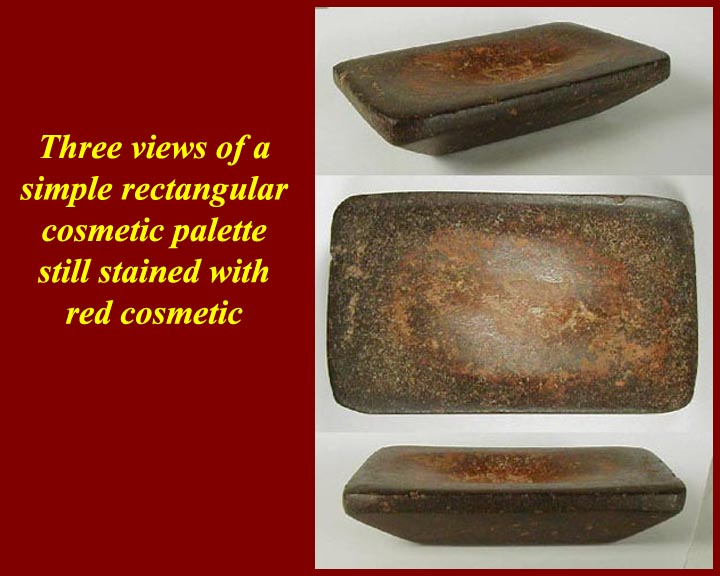
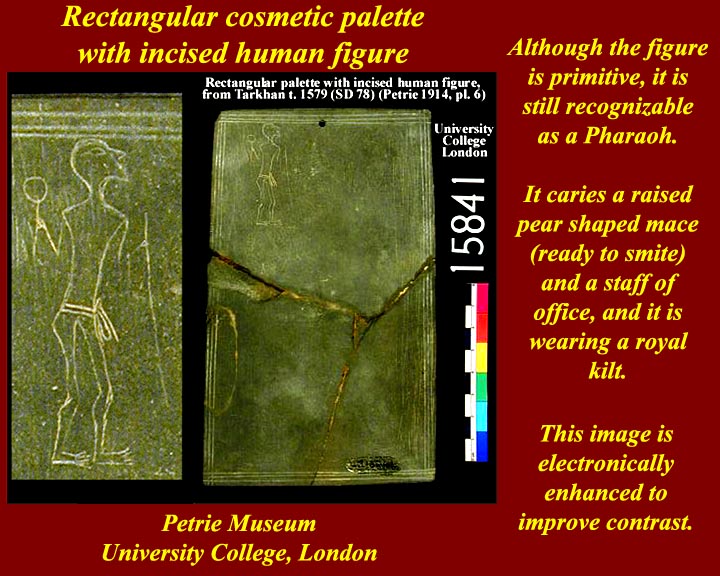
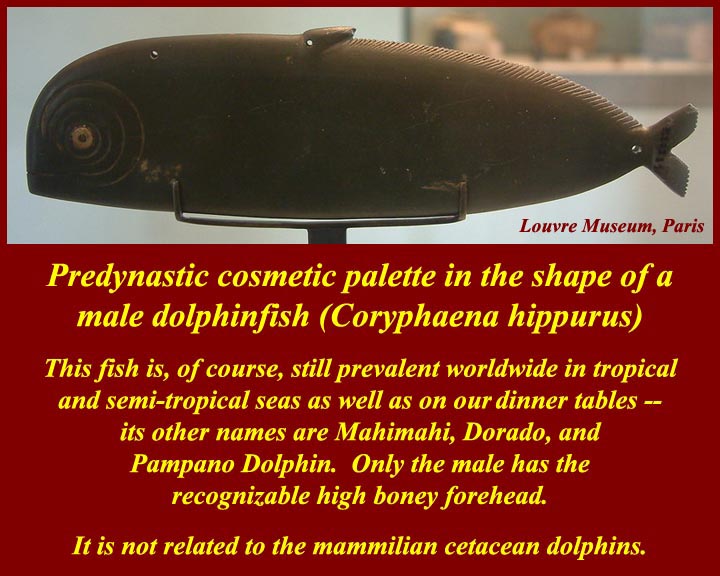
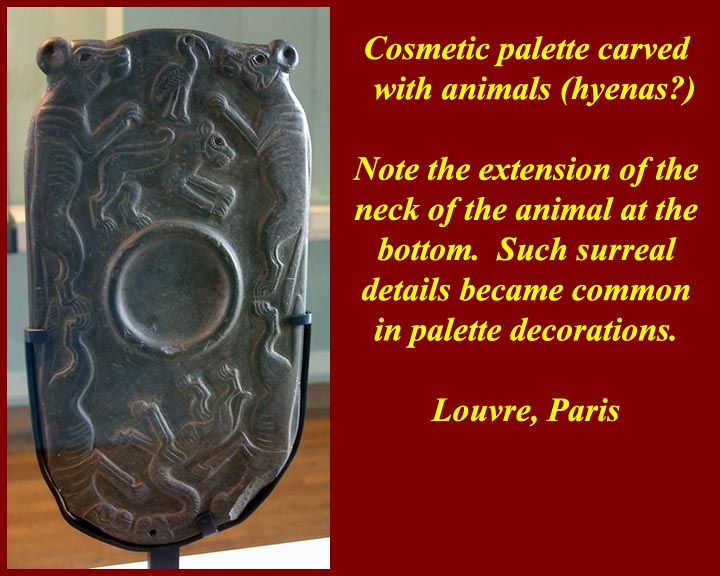
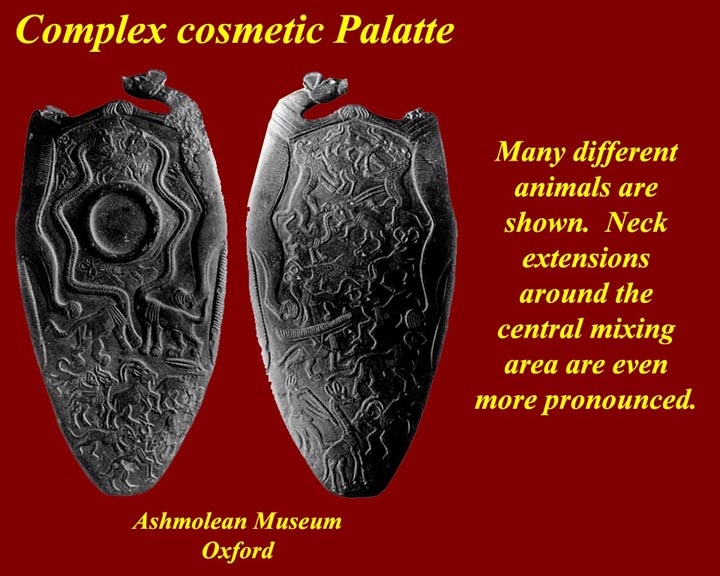
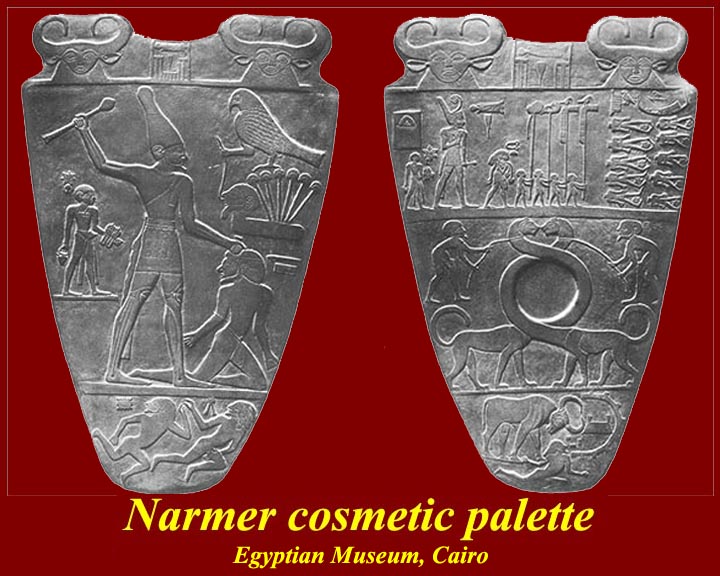
http://www.mmdtkw.org/EGtkw0201PaletteRectangular.jpg
http://www.mmdtkw.org/EGtkw0202IncisedCosmetic Palette.jpg
http://www.mmdtkw.org/EGtkw0203DolphinPalette.jpg
http://www.mmdtkw.org/EGtkw0204HyenaPalette.jpg
http://www.mmdtkw.org/EGtkw0205OxfordAshmoleanPalette.jpg
http://www.mmdtkw.org/EGtkw0206NarmerPalette.jpg
As we know from all those Cleopatra movies, cosmetics were very important in Ancient Egypt. Organic and inorganic powders were crushed and mixed with animal fats and applied to the skin and hair for beautification and for medicinal purposes. In pre-, proto-, and early dynastic times the pulverizing and mixing was done on stone palettes that, over the centuries, transformed from simple rectangular stones to highly ornate large ceremonial pieces. Early cosmetic palettes provide a chronology of both ornamentation and of the development of hieroglyphic writing.
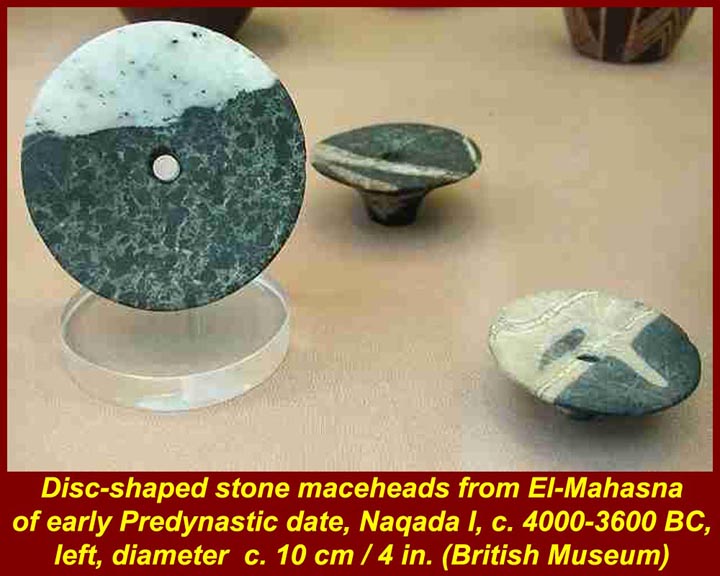
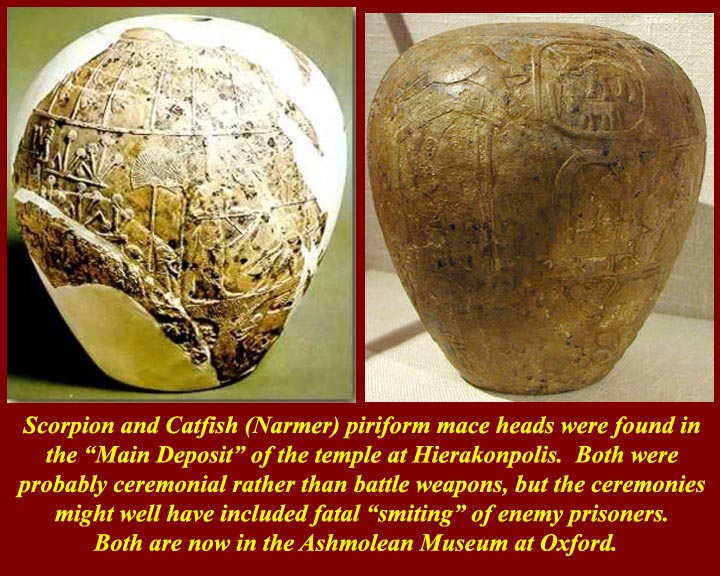
http://www.mmdtkw.org/EGtkw0159Macehead1Naqada.jpg
http://www.mmdtkw.org/EGtkw0207MaceHeads.jpg
Predynastic mace heads were shaped like a soup bowl but with no depression on the inside. During the protodynastic period those went out of style and were replaced by periform (= pear shaped) mace heads like the ones in the second image. Both styles were just glorified clubs, but throughout the dynastic period, well after edged metal weapons came into the area, maces remained the ceremonial weapon of choice used by Pharaohs to smite their enemies.
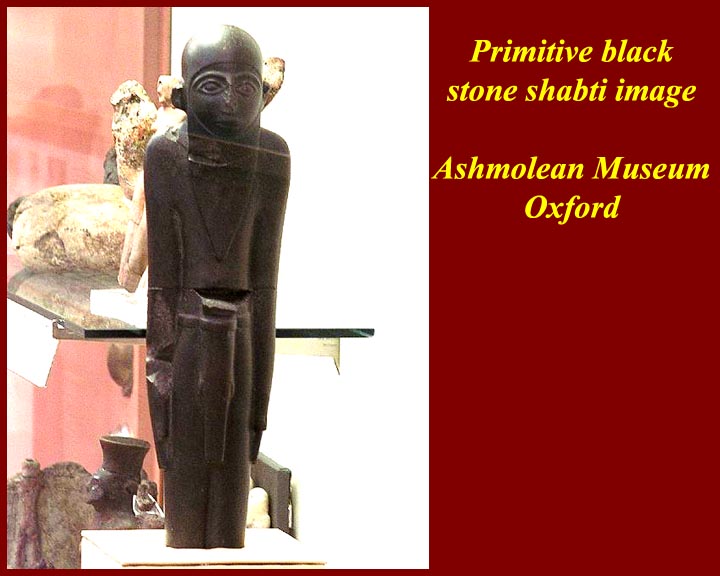
http://www.mmdtkw.org/EGtkw0208Shabti.jpg
Small image -- one of the guys. Already in proto-dynastic times, small human figures were being placed in Egyptian graves. They had various duties: be a stand-in for the deceased, be a servant or worker, just be there as a friend, and most importantly (at least to the real people around the Pharaohs), be a stand-in for a human sacrifice. They are variously called shabtis, shawabtis, or ushabtis or other versions of the same root. There is an Arabic word that may be a cognate: shab (plural = shabab) that means guy (pl., guys). We might also call them "people" as in "have your people call my people" (i.e., flunkies). For more info about all these guys, go to http://www.touregypt.net/featurestories/ushabti.htm.
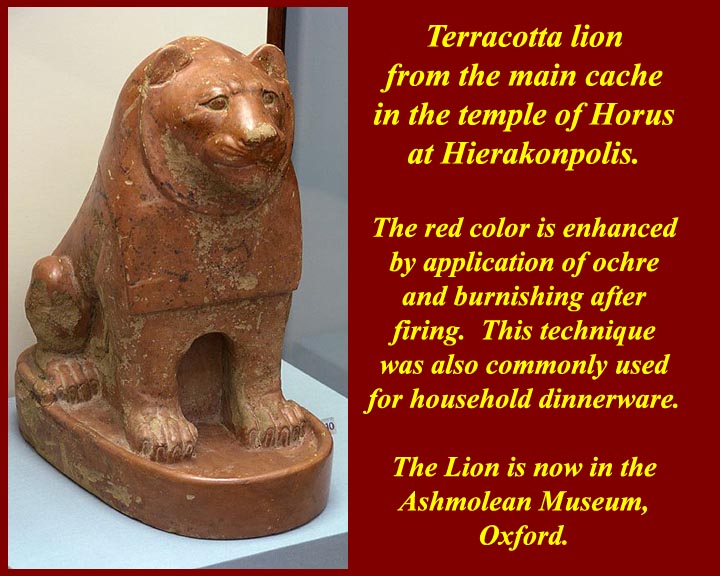
http://www.mmdtkw.org/EGtkw0209RedLion.jpg
Pharaohs liked to hunt lions, to be associated with lions, and to be portrayed as lions (at least partially as lions), i.e., sphinxes. There were lions all along the Nile in those days and even further north along the eastern Mediterranean coast. Scat and pug marks attributed to lions were found in the swamps around Ein Gedi on the Dead Sea as recently as the 1980s.
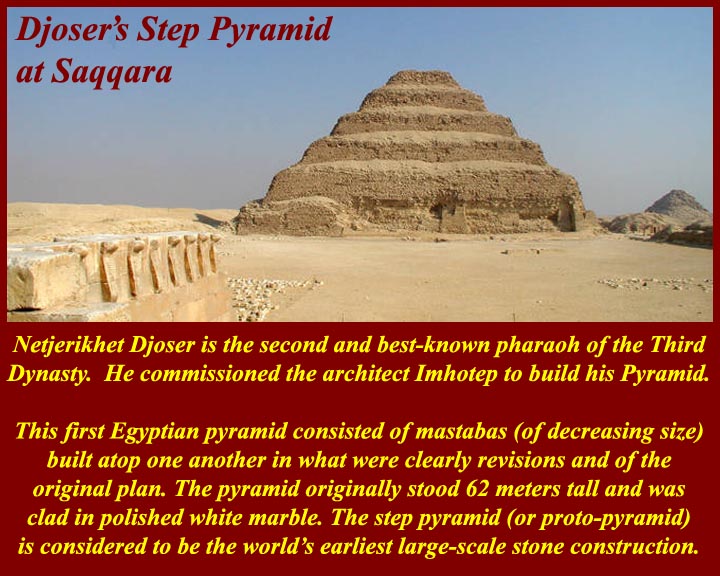
http://www.mmdtkw.org/EGtkw0210DjoserStepPyramid.jpg
Imhotep! Imhotep! Imhotep! Imhotep! the chant gets louder and louder as the minions of The Mummy call for their leader in all the mummy movies ever made. The real historic Imhotep was an old kingdom renaissance man who was eventually deified as the Egyptian god of medicine -- one of his many skills. He is also credited with inventing the Egyptian pyramid, because, as Djoser's architect, he built this step-pyramid by stacking progressively smaller mastabas on top of each other. A mastaba (Arabic for bench) is a single level structure built over a tomb, and it's what preceded the pyramids. Djoser was a 3rd Dynasty Pharaoh.
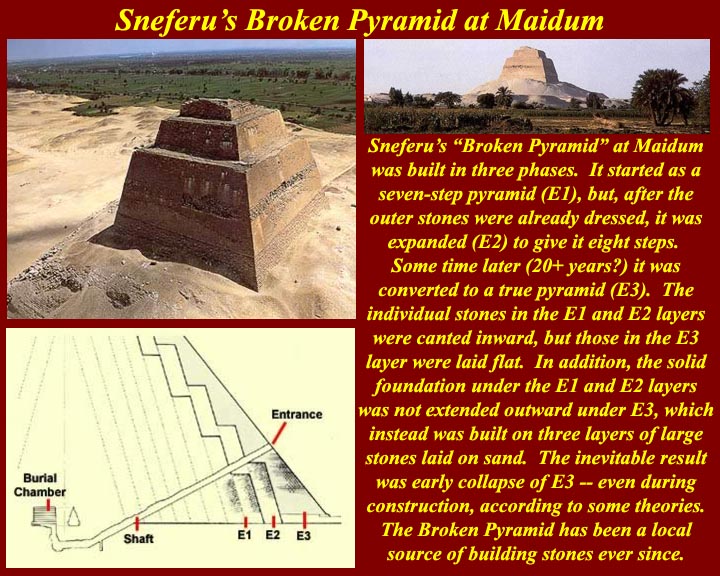
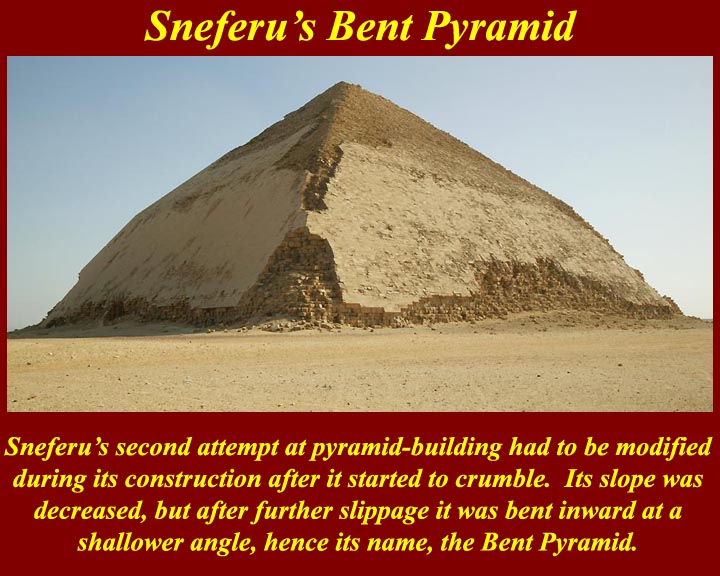
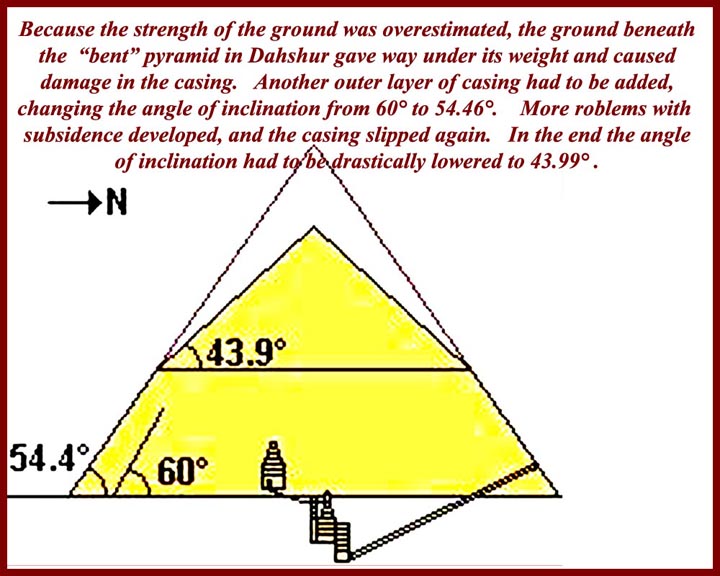
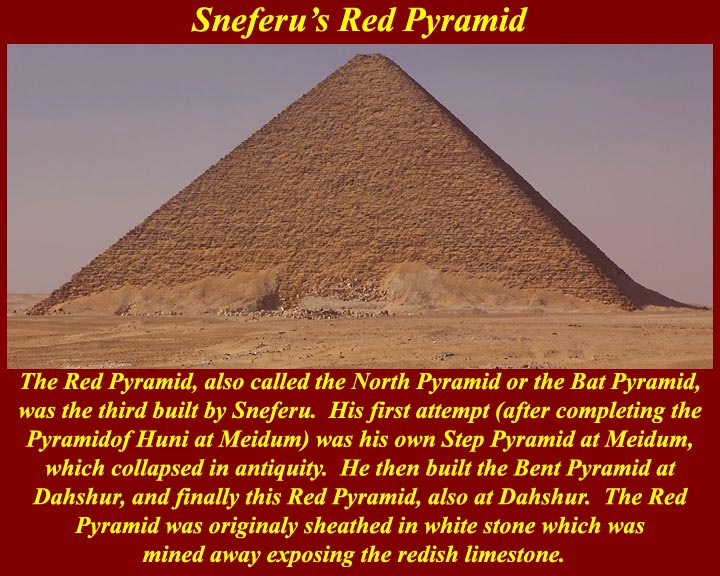
http://www.mmdtkw.org/EGtkw0211SneferuBrokenPyramid.jpg
http://www.mmdtkw.org/EGtkw0213SneferuBentPyramid.jpg
http://www.mmdtkw.org/EGtkw0212BentPyramidPlan.jpg
http://www.mmdtkw.org/EGtkw0214SneferuRedPyramid.jpg
Sneferu was the founder of the 4th Dynasty and was Egypt's most prolific builder of large pyramids. He had to keep trying until he got it right. The beginning of his pyramid building is a bit obscure. There are references to him completing the pyramid of his father, Huni, but we don't know whether that pyramid was the one we know as the "Broken Pyramid" or whether the Huni pyramid and the Broken Pyramid are two different structures. We do know that the Broken Pyramid was completed by Sneferu and that it fell down almost immediately: the outer shell that made it a true (as opposed to step) pyramid was not canted inward and, worse still, was built on sand. His second attempt resulted in the "Bent Pyramid" which had to be modified twice during construction to prevent it from being another "broken" pyramid. Despite the problems of the Bent Pyramid, it has retained more of its outer casing than any other large pyramid (see image). His third pyramid is the Red Pyramid, which is the first successful true pyramid -- even though the slope of the sides is pretty shallow compared with the slopes of the three Great Pyramids at Giza. A recent (July 2007) internet search for the words Sneferu and Pyramid found more than 12000 internet sites that discuss his pyramids -- and that's only with one of the several spellings of his name.
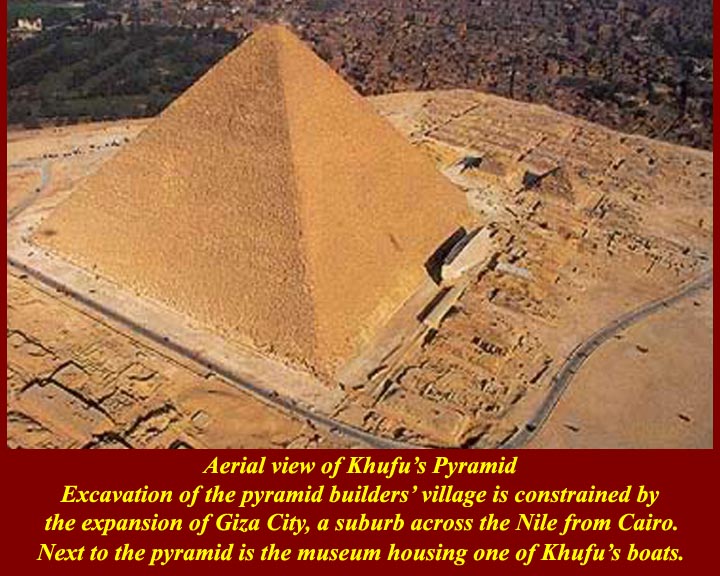
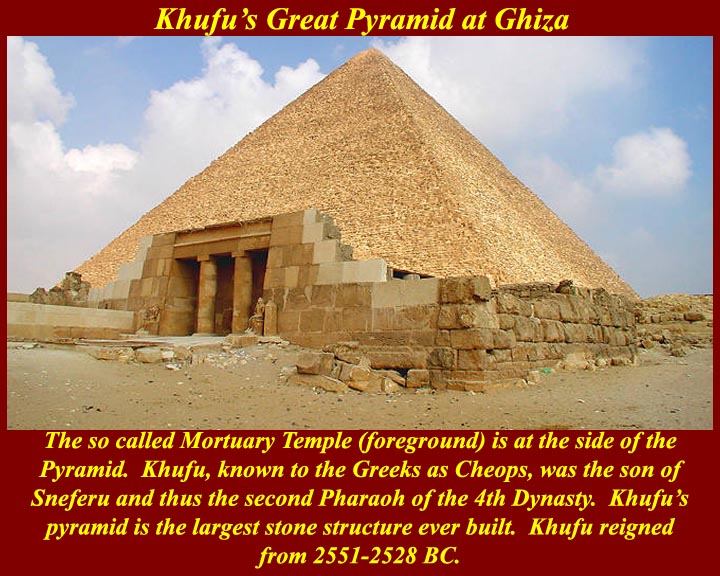
http://www.mmdtkw.org/EGtkw0215KhufuPyramid1.jpg
http://www.mmdtkw.org/EGtkw0216KhufuPyramid2.jpg
Khufu was the son of Sneferu, and Khufu's pyramid is the biggest of the big three at Giza. It's also known as The Great Pyramid of Giza. A trend was clearly developing, which is why the Old Kingdom was known as the Age of Pyramids. This pyramid alone used more than two million blocks each weighing 1 - 1.5 tons, a good portion of which were quarried more than 500 miles away. Modern science has estimated the number of workers and the time necessary for building this and other pyramids, but the estimates vary wildly: 350,000 men for 23 years, or 40,000 for 10 and a lot of other numbers in between. The Ancient Egypt Research Associates (AERA) Internet page at http://www.aeraweb.org/khufu_quarry.asp goes into a lot of detail about the source of the main part of the stone from local quarries. Another Internet site with information on the Khufu Pyramid is at http://www.cheops-pyramide.ch/khufu-pyramid/khufu-numbers.html.
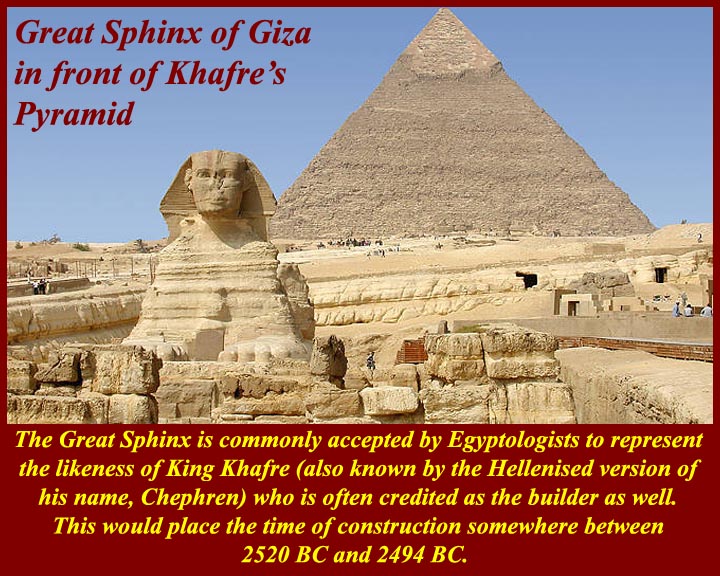
http://www.mmdtkw.org/EGtkw0217SphinxKhafrePyramid.jpg
Khafre, the son of Khufu, built his own pyramid beside that of his father. It is smaller, but it is the only one of the three Great Pyramids at Giza to retain any of its casing -- near the top where it is inaccessible except by telescope. The Casings did not fall from the Great Pyramids: rather they were mined away as material to build Islamic Cairo.
Khafre is also the most likely builder of the Great Sphinx and it's thought to be his face that adorns it. The Great Sphinx was the largest monolithic sculpture in the world until the mid 8th century AD when the amazing rock-cut Kailasa temple dedicated to Hindu god Shiva was built in the Ellora caves in Maharashtra, India (picture at
http://www.mmdtkw.org/EGtkw0287KailasaTemple.jpg). Both the Kailasa temple and the Great Sphinx were built by carving away surface stone until only the sculpture remained -- they both therefore stand in very large man-made depressions. The Sphinx was actually harder to carve because the quality and hardness of stone varied from one place to the next: the softer parts were the trickiest and required the most care in stone-carving so that they would not shatter and fall away. Some stone experts speculate that a soft section in front of the hind-quarters is the reason that the body of the Sphinx is so long: the carvers wanted harder stone, from which to carve the curves of the giant backside, so the stretched out the body until they got to some better stone.
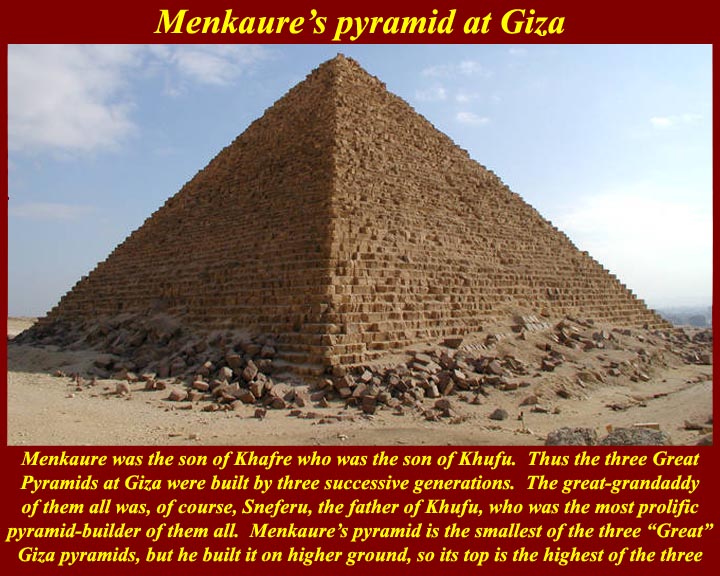
http://www.mmdtkw.org/EGtkw0218MenkaurePyramid.jpg
Menkaure's pyramid is the smallest of Giza's big three, but, being the clever son of Khafre, grandson of Khufu, and great-grandson of Sneferu, Menkaure built his pyramid on a natural rise on the Giza Plateau, and its top is higher than the others.
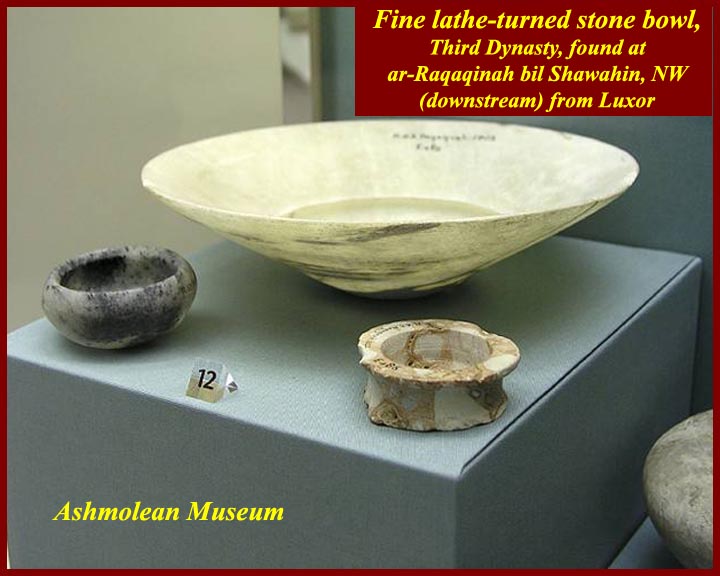
http://www.mmdtkw.org/EGtkw0219-3rdDynastyBowl.jpg
Old Kingdom mastery of stone was not limited to huge architectural works. Note the thinness of the sides of this 3rd Dynasty lathe-turned bowl.
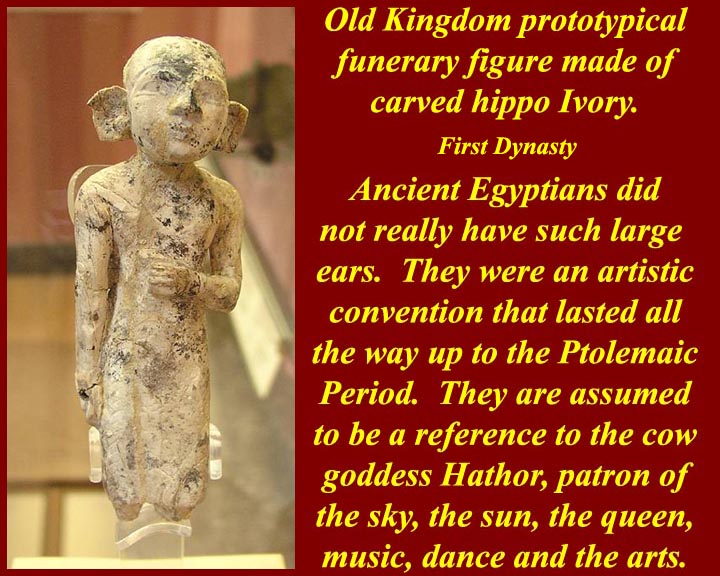
http://www.mmdtkw.org/EGtkw0220HippoIvory1st.jpg
There are still hippopotami in the Nile River. During the 1st Dynasty, an ivory carver used a hippo tooth as raw material for this big eared figure.
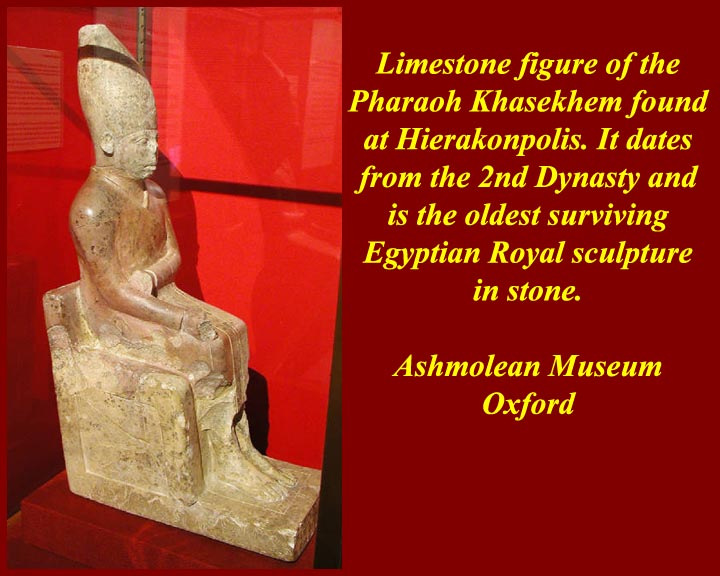
http://www.mmdtkw.org/EGtkw0221Pharaoh2ndDyn.jpg
Pharaoh Khasekhem sits in the oldest known Egyptian royal sculpture -- 2nd Dynasty.
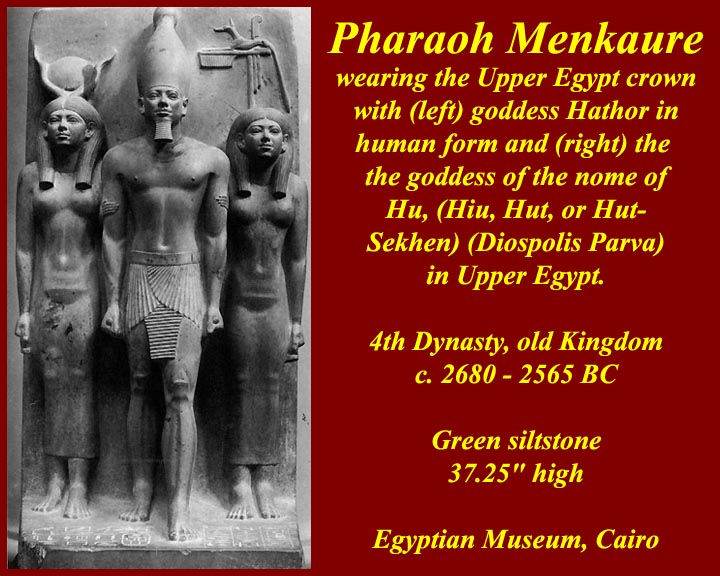
http://www.mmdtkw.org/EGtkw0222Menkaure4thDyn.jpg
Pharaoh Menkaure (of the third Giza Pyramid -- 4th Dynasty) with goddesses Hathor (horns on her head) and the local goddess of the Hiu nome or province (nome standard above her head).
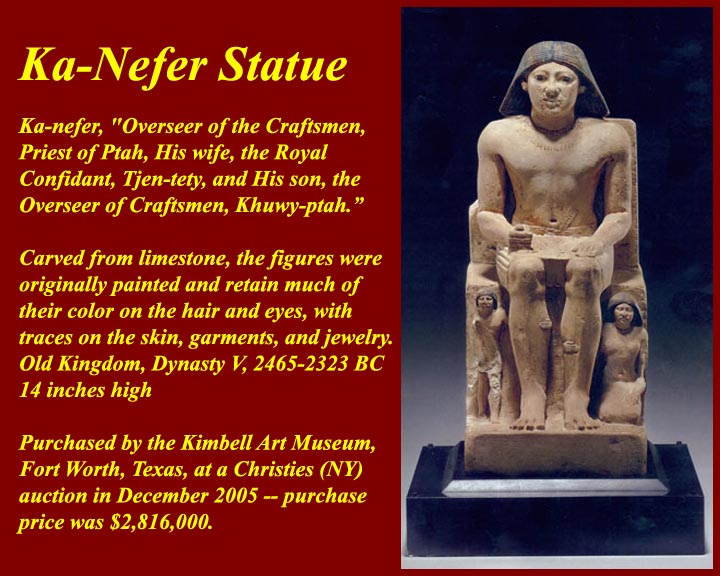
http://www.mmdtkw.org/EGtkw0223KaNeferStatue.jpg
Ka-Nefer, a 5th Dynasty bureaucrat.
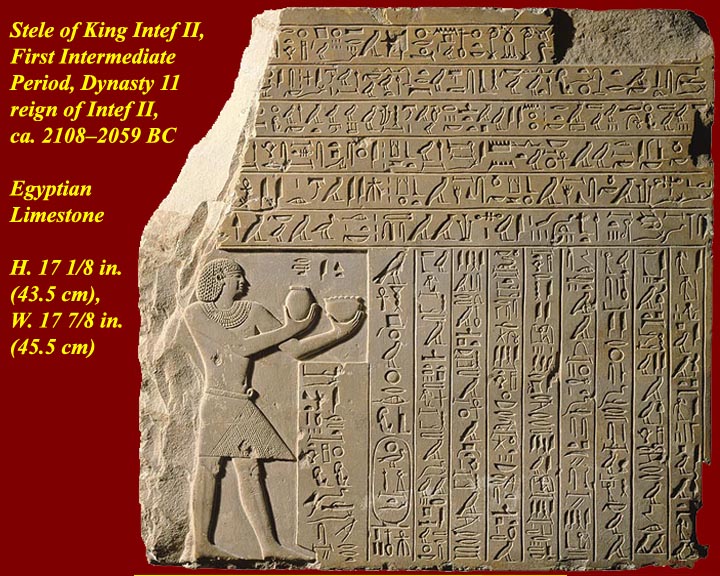
http://www.mmdtkw.org/EGtkw0224-1stIntermediateStele.jpg
The last Pharaohs of the Old Kingdom decentralized giving wide powers to governors of the nomes. Soon the governors developed pharaonic ambitions and the result was the 1st Intermediate Period. Central authority lost control, and Egypt was in pieces. Things didn't come back together again until the late 11th or early 12th dynasty. "Pharaohs" of the intermediate period really only ruled in their own localities, and there were times when more than one claimant to the crowns were seated in their respective nomes.
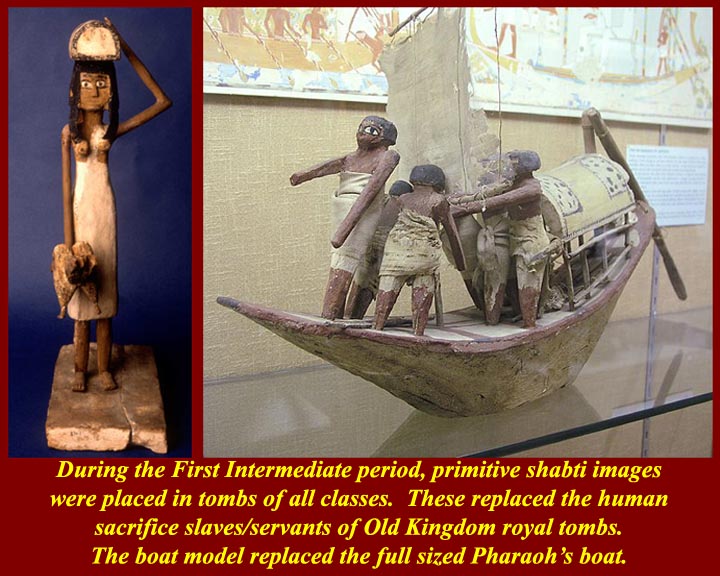
http://www.mmdtkw.org/EGtkw0225BoatModel.jpg
In the first intermediate period, a phenomenon that Egyptologists call "the democratization of the afterlife" occurred. Death rights and grave goods that had previously been reserved to members of the Pharaoh's family spread to all classes. Even lower class graves now contained helpers, and tombs other than those of pharaohs could contain boats to take the spirit of the deceased to the Pole Star. The boats, of course, were models rather than the full size boats found around the Giza pyramids, and the helpers were primitive "action figures" rather than the real (dead) people who accompanied the Pharaohs of the Old Kingdom.
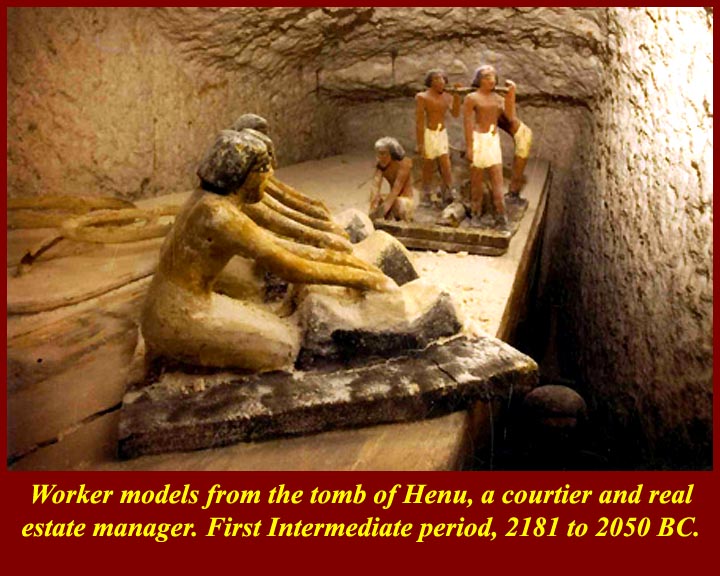
http://www.mmdtkw.org/EGtkw0226WorkerModels.jpg
Even Real Estate managers took workers (models) with them. Every Egyptian firmly believed that he/she could "take it with him/her".
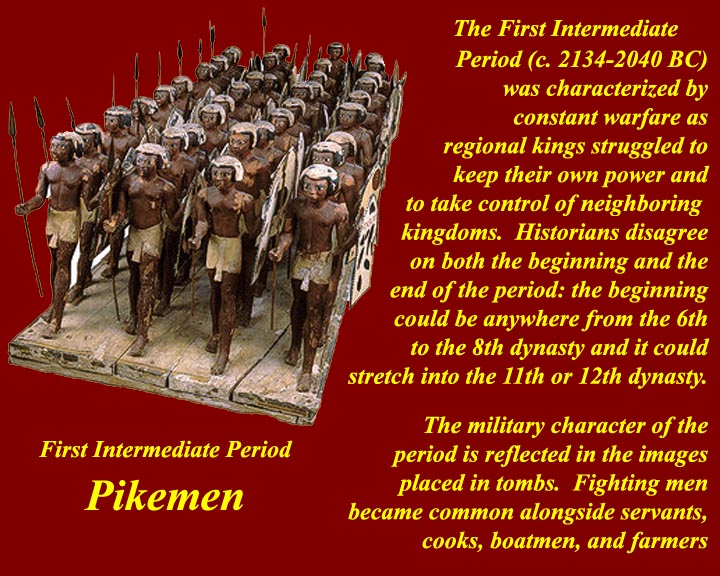
http://www.mmdtkw.org/EGtkw0227Pikemen.jpg
Local leaders -- all claiming at least the prerogatives if not the titles of pharaohs -- fought each for power, and they apparently thought the struggles would continue in the afterlife.
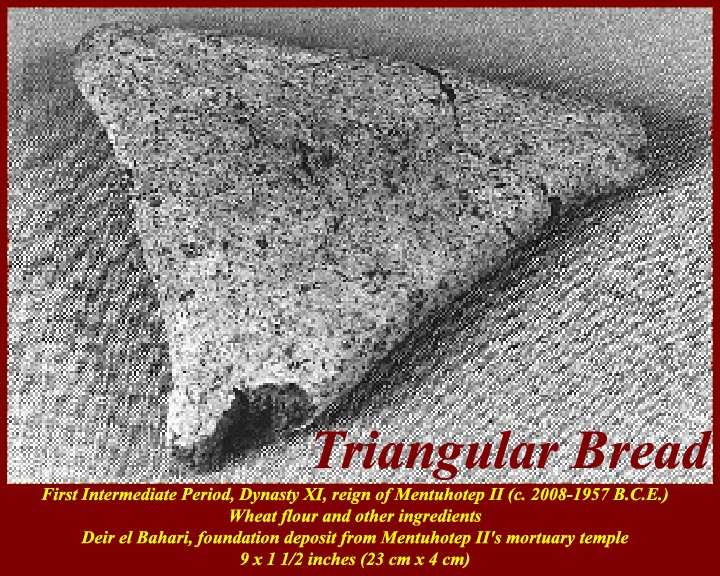
http://www.mmdtkw.org/EGtkw0228-1stIntermediateBread.jpg
Stale bread.
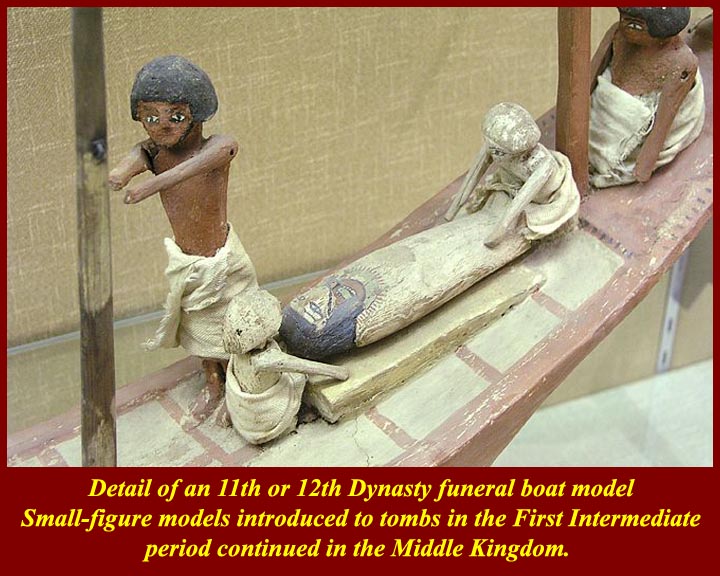
http://www.mmdtkw.org/EGtkw0229Boatmodel11-12th.jpg
The small grave figures of the 1st Intermediate Period continued to be used in the Middle Kingdom and beyond.
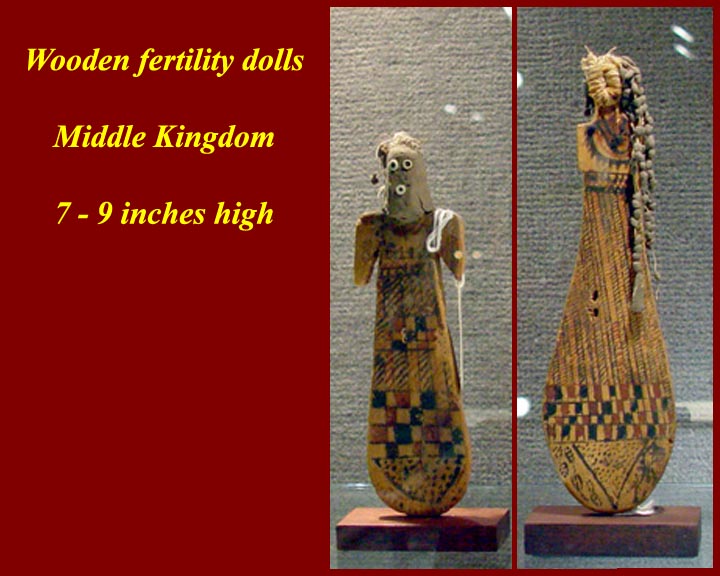
http://www.mmdtkw.org/EGtkw0230FertilityDolls.jpg
Fertility dolls, Middle Kingdom.
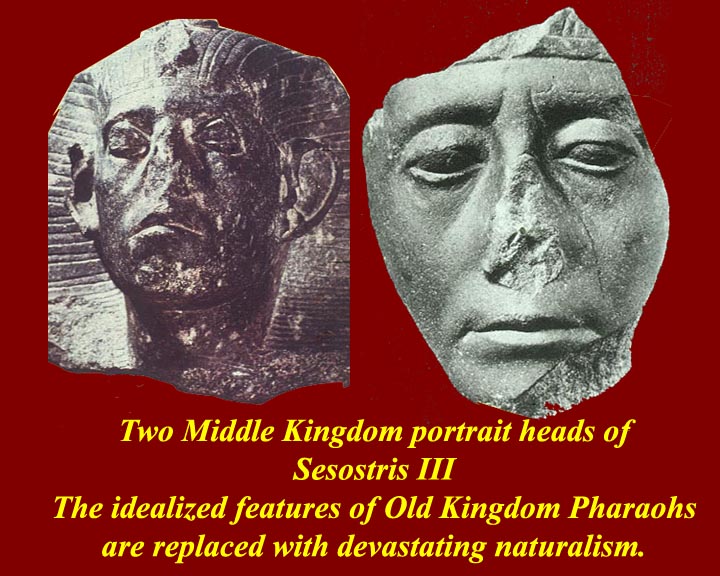
http://www.mmdtkw.org/EGtkw0231SesostrisIII.jpg
Naturalistic Middle Kingdom images replaced the idealized portrait sculpture of the Old Kingdom.
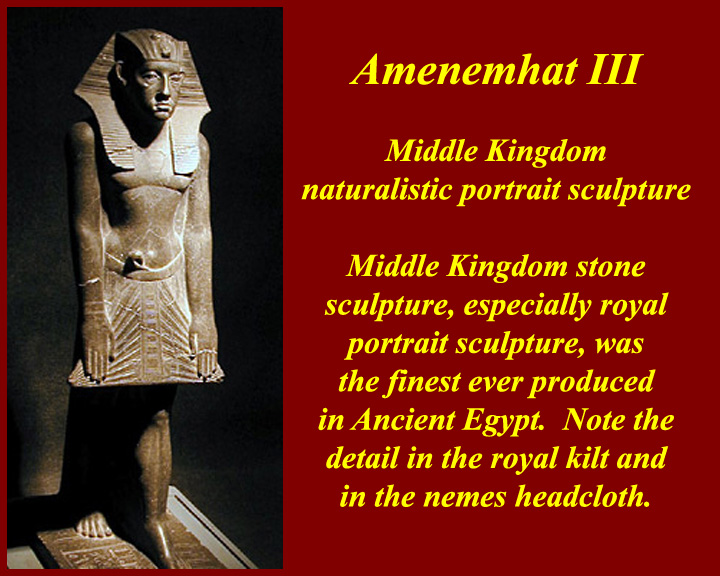
http://www.mmdtkw.org/EGtkw0232AmenemhatIII.jpg
Middle Kingdom sculpture, both in reliefs and in the round, achieved a higher level of fineness and detail than that of any other ancient Egyptian period.
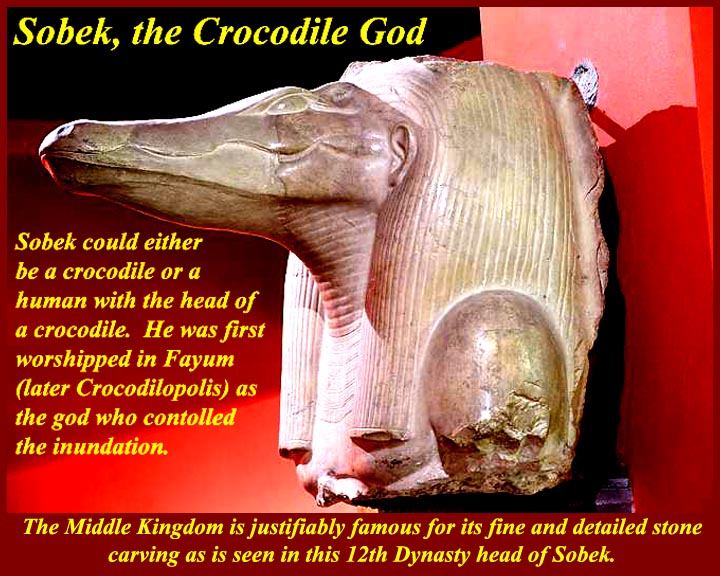
http://www.mmdtkw.org/EGtkw0233Crocodile12th.jpg
The late 12th Dynasty was the height of Egyptian stone sculpture. Image of the Crocodile god, Sobek.

http://www.mmdtkw.org/EGtkw0234MidddleKPyramids.jpg
Size isn't everything. The 4th Dynasty Giza Pyramids (Old Kingdom) were the Egyptian maximum in size, and the shrinking continued into the Middle Kingdom. Pyramids now were also built of less durable material, like this, which is mostly of mud brick. Nevertheless, that's a lot of bricks.
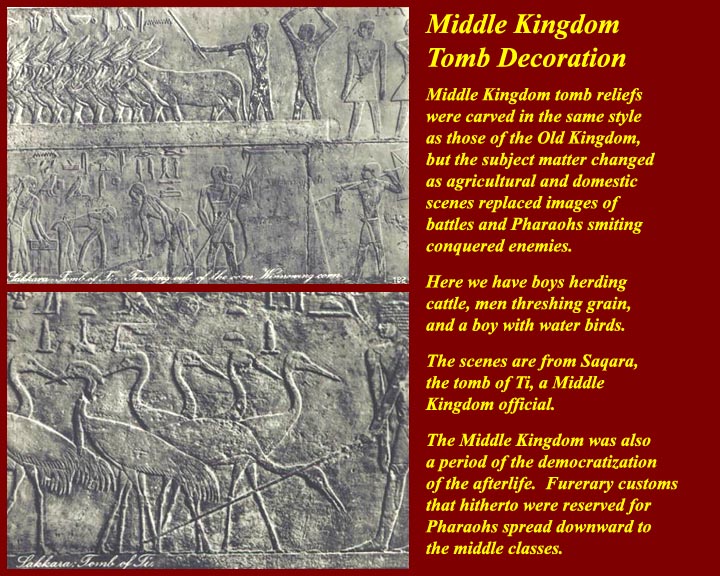
http://www.mmdtkw.org/EGtkw0235MiddleKingdomTombReliefs.jpg
Democratization of the afterlife also meant that tomb reliefs could show something other than the Pharaoh smiting his enemies. River and agricultural scenes like these became common.
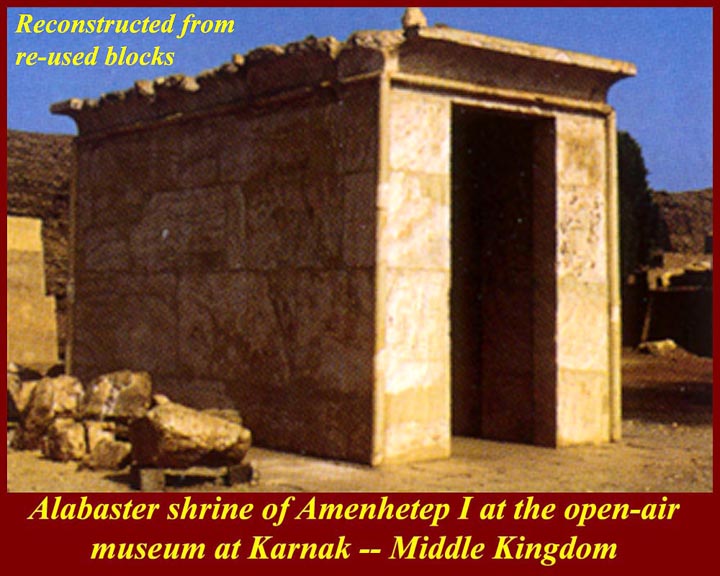
http://www.mmdtkw.org/EGtkw0236AlabasterShrine.jpg
The religious complexes in Thebes (modern Luxor -- the Luxor and Karnak temple sites) didn't reach their height until the New Kingdom, but, already in the Middle Kingdom, Pharaohs were building shrines there. Unfortunately, most of them were replaced with much larger temples. Middle Kingdom shrines were unceremoniously demolished and their stones were used mostly for fill in the interior of the huge New Kingdom pylons (= gateways). Ironically, that saved the artwork. Modern archeologists found the stones during excavations and painstakingly put some Middle Kingdom shrines back together again in the Open Air Museum at Karnak.
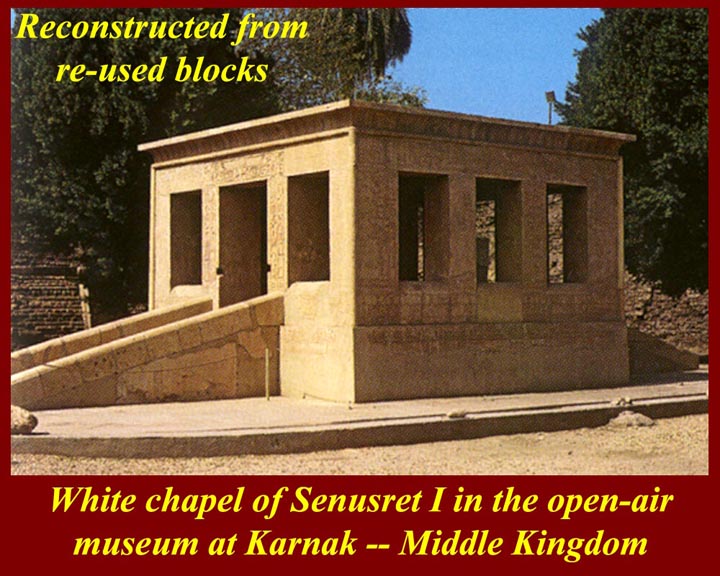
http://www.mmdtkw.org/EGtkw0237WhiteChapelSenusretIKarnak.jpg
Another Middle Kingdom shrine reconstructed in the Karnak Open Air Museum.
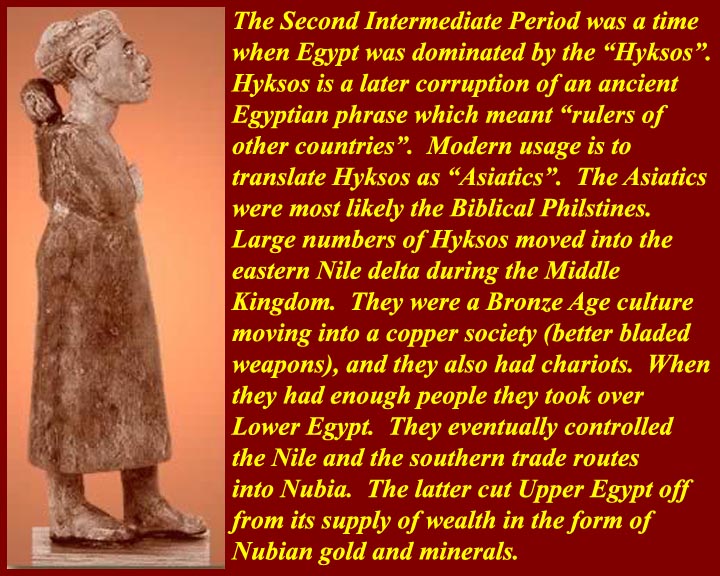
http://www.mmdtkw.org/EGtkw0238Hyksos.jpg
During the Middle kingdom (part of the 11th, and the 12th and 13th Dynasties) many "Asiatics" started to move into the eastern side of the Nile delta. Although there is still some discussion about their geographic and ethnic origins, it is now generally thought that they were from ancient Palestine (i.e., Philistines). Although quite advanced the Egyptians of that time were still in the age of copper weapons. The Asiatics, on the other hand, were already in their Bronze Age and, more importantly, they had already invested in chariot technology. The Egyptians were still fighting on foot.
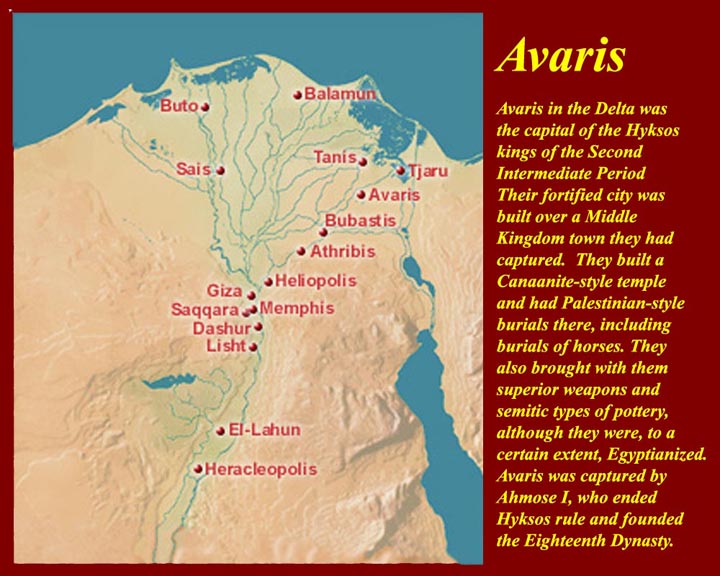
http://www.mmdtkw.org/EGtkw0239AvarisMap.jpg
Although some sources talk of an invasion, in fact, the Asiatics just moved in and were initially accepted by the Egyptians, who called the leaders of the Asiatics heqa khasewet, "foreign rulers" in ancient Egyptian. When the Greeks later wrote their histories of the time, they corrupted the Egyptian name to "Hyksos" and that's the name for them that came down to us. (The "Asiatic" designation is from the 18th or 19th century.) Eventually a Hyksos power center emerged at Avaris, and that became the Hyksos capital from which they ruled as the "Pharaohs" of the 15th and possibly 16th Dynasties (based on contradictory king lists) during the Second Intermediate Period.
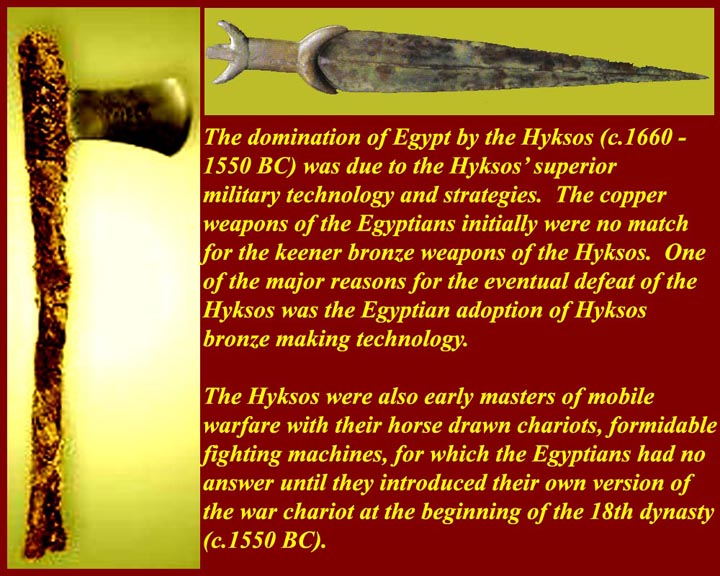
http://www.mmdtkw.org/EGtkw0240HyksosWarTech.jpg
As noted above, the Hyksos had superior edged weapons and chariots, which allowed them to take over when their numbers were sufficient. They first took the Delta and later were able to control the trade routes all the way down into Nubia. Egyptians still held many centers along the Nile, but the all important trade routes to the east through the Delta and to the south (where Nubian gold came from) were denied to them.
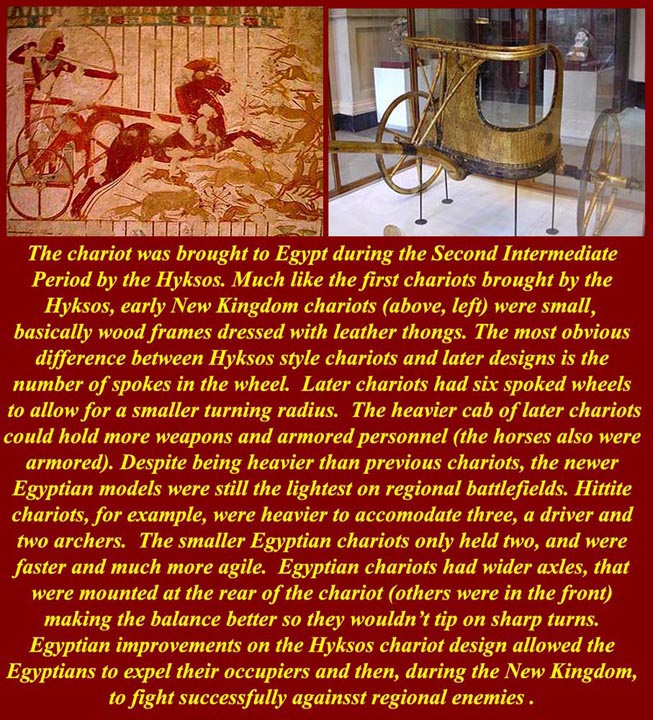
http://www.mmdtkw.org/EGtkw0241Chariots.jpg
The Egyptians -- especially those around Thebes -- quickly adopted Hyksos military technology and within a short time they had improved on the Hyksos chariot. The Egyptian chariot was sturdier and could carry two fighters, one of which would drive while the other used a composite bow. The Egyptians also placed a wider axle at the back of the chariot, greatly increasing its stability, and used sturdier six-spoked wheels that wouldn't snap on sharp turns. All in all, the Egyptians picked up a lot of technology from the Asiatics in this period.
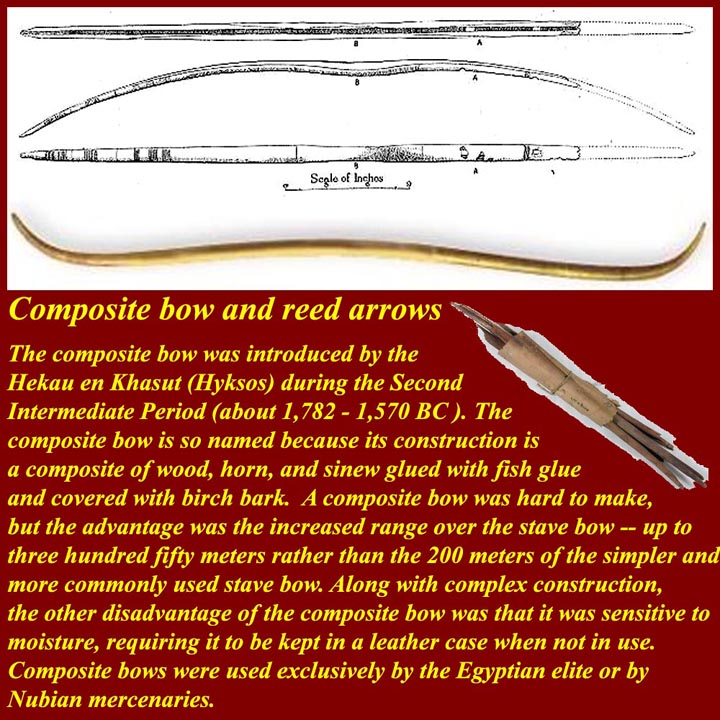
http://www.mmdtkw.org/EGtkw0242Archery.jpg
The Egyptians also improved archery technology. The Egyptian composite bow had a 50% range advantage over the earlier stave bow (made of a single piece of wood) and the introduction of recurved bows increased the initial velocity of the arrows giving them a flatter trajectory. Archers in those days fired at individual targets and did not fire the arching volleys introduced by Roman auxiliary formations and used so devastatingly by the British on St. Crispin's Day.
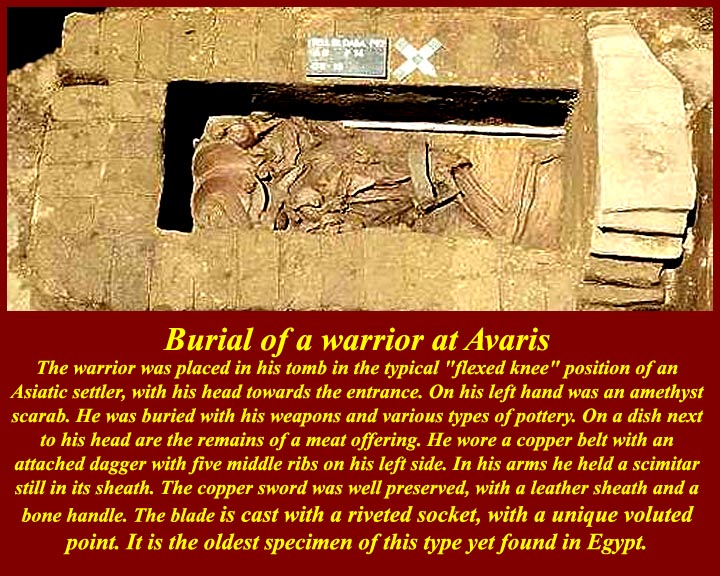
http://www.mmdtkw.org/EGtkw0243AvarisWarriorBurial.jpg
Hyksos burials were much more simple than what had evolved among the Egyptians. This warrior was burried with his weapons and a few grave goods. The weapons tell the story of why the Egyptians were able to expel the Hyksos
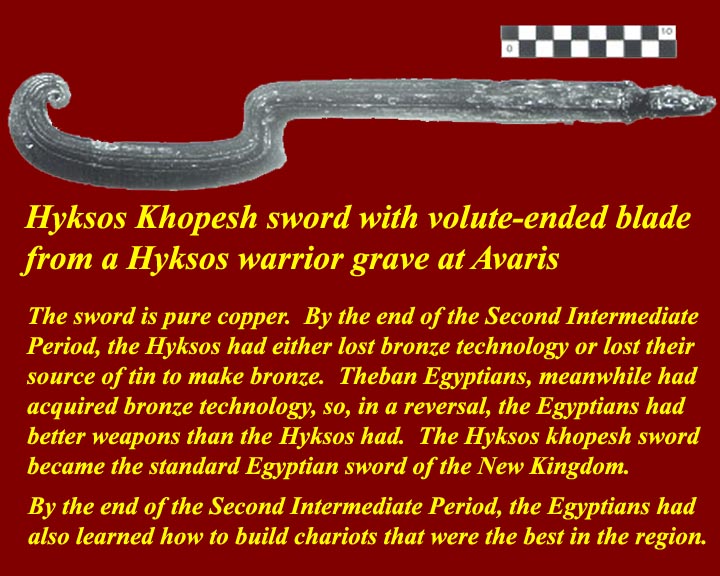
http://www.mmdtkw.org/EGtkw0244AvarisWarriorBurialSword.jpg
The sword in the hand of the dead Avaris warrior was made of solid copper. Remember that the Hyksos had arrived in the area with bronze weapons. By the end of the 2nd Intermediate Period most Hyksos weapons had reverted to copper technology either because the had lost bronze technology, or because the had lost their source of tin that was needed to make bronze, or because they had gotten soft and lazy and complacent. The Egyptians had plenty of local tin, and they had been busy making lots of bronze weapons -- occupied people seldom get soft or lazy or complacent.
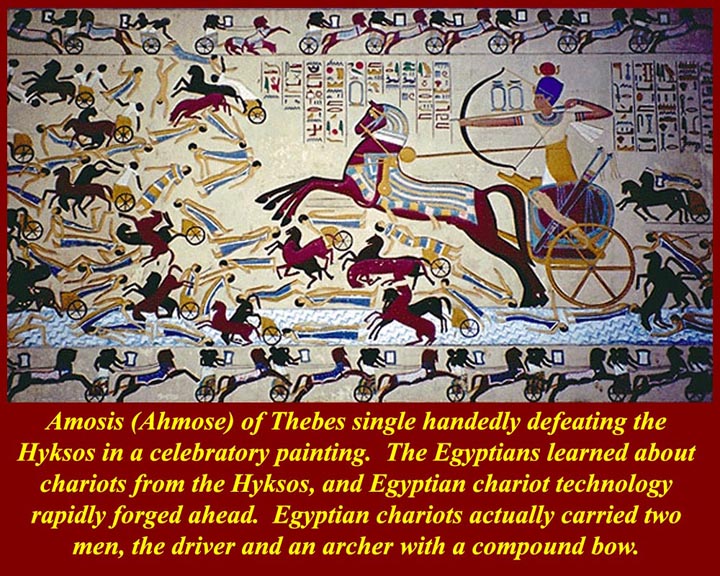
http://www.mmdtkw.org/EGtkw0245HyksosDefeated.jpg
Ahmosis of Thebes defeating the Hyksos using newly acquired military technology. No mere smiter he. Ahmose founded the 18th Dynasty.
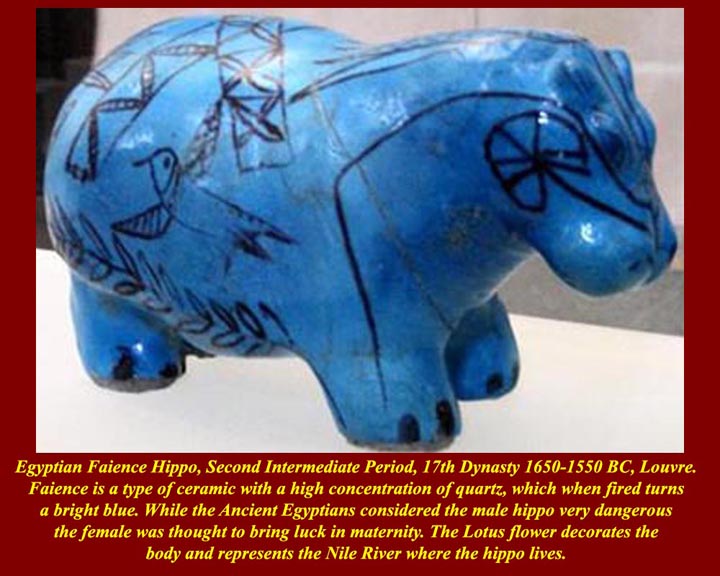
http://www.mmdtkw.org/EGtkw0246Hippo.jpg
A faience hippo from the 2nd Intermediate Period. Male Hippos were considered to be dangerous and monstrous. Females were equally dangerous, but they were revered for their motherliness and protectiveness of their babies. There was even a hippo goddess of motherhood and childbirth named Taweret. Read about her at http://www.touregypt.net/featurestories/taweret.htm.
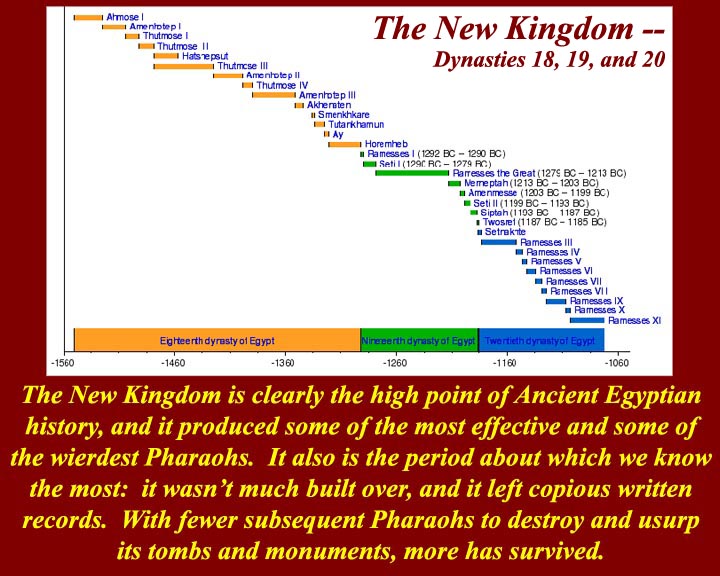
http://www.mmdtkw.org/EGtkw0247NewKingdomPharaohs.jpg
The New Kingdom was essentially the Theban monarchy writ large.
It was the high point of ancient Egyptian history and produced many of the well known pharaohs.
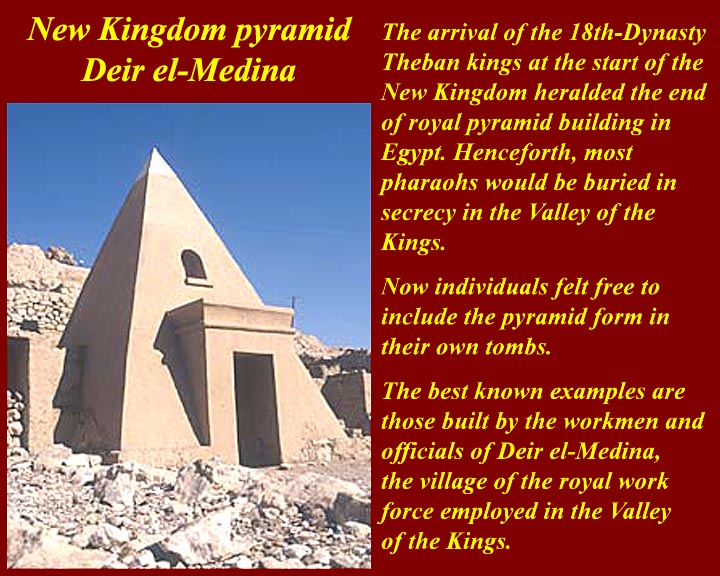
http://www.mmdtkw.org/EGtkw0248PyramidDeirAlMedina.jpg
Fully aware that the tombs of earlier dynasty pharaohs had been plundered, the Theban kings of the New Kingdom stopped building great monuments to mark their tombs. In fact, they tried to hide them away in the remote valleys on the west side of the Nile opposite Thebes. They also collected mummies from earlier royal tombs that had been despoiled and reburied them in two New Kingdom tombs in the Valley of the Kings. (But their precautions didn't prevent their tombs from being plundered.)
Since the pyramid was no longer a royal prerogative, it was adopted by the lower ranks. Lower rank pyramids were either free standing with an entrance to the funerary chapel or were built on the roof of funerary chapels. The ancient Romans also later used Pyramids on some of their tombs and one big one -- that of Cestius -- is still built into Rome's Aurelian walls on the south side of the city next to the Ostia Gate. A picture of the 35 meter Pyramid of Cestius is at http://www.romaturismo.com/operatoriprofessionali/medi/Img1057.jpg.
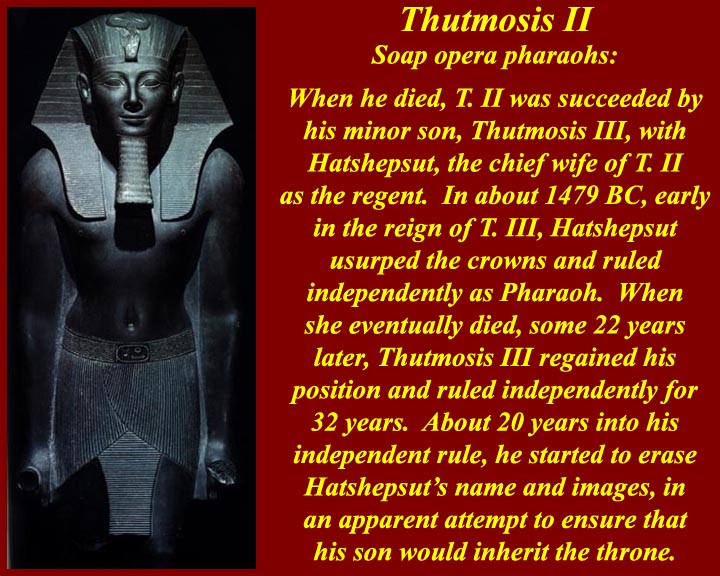
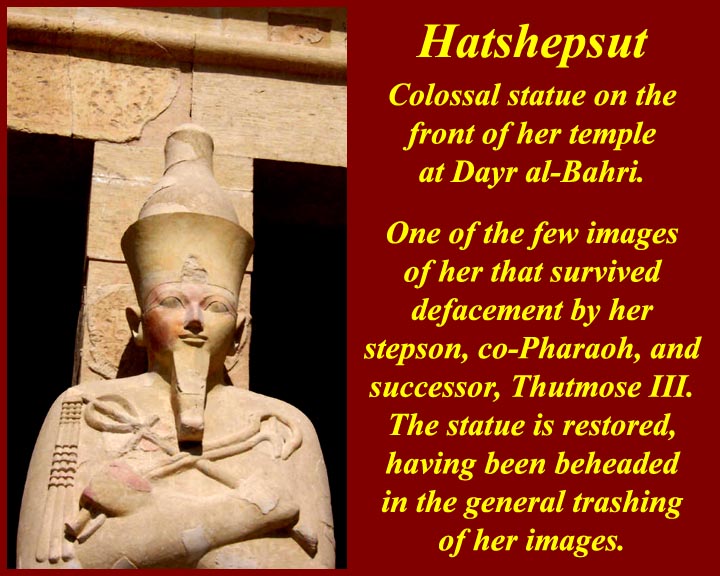
http://www.mmdtkw.org/EGtkw0249Thutmose.jpg
http://www.mmdtkw.org/EGtkw0250Hatshepsut.jpg
Thutmosis II the 4th Pharaoh of the 18th Dynasty died and left his kingdom to his minor son, Thutmosis III. His will made his chief wife (who was not the mother of Thutmosis III) regent. Shortly thereafter, maybe in the first year after the death of Thutmosis II, She took over and started to rule as Pharaoh. She ruled for 22 years and was Egypt's most successful and longest ruling female Pharaoh (except for some of those foreign girls, the Cleopatras).
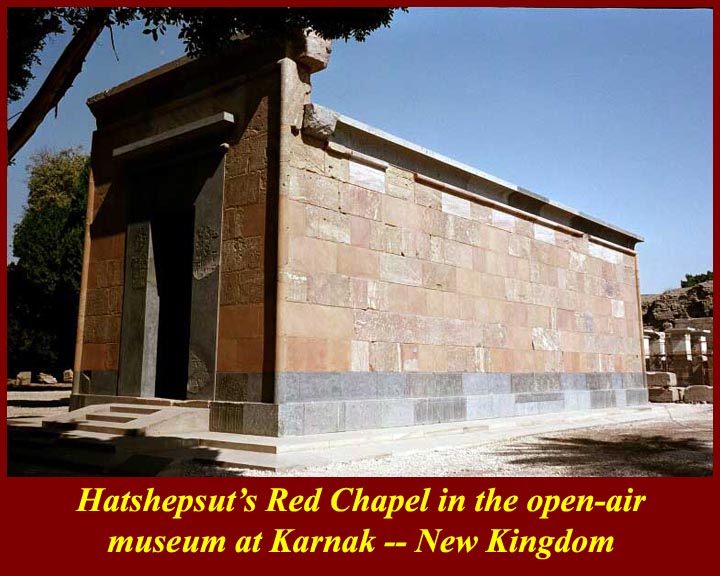
http://www.mmdtkw.org/EGtkw0251aRedChapelHatshepsutKarnak.jpg
To validate her claim to the pharaonic crowns, Hatsheptut embarked on huge building programs. She mad major additions to Luxor and Karnak (mostly defaced by Thutmosis III) including this small red quartzite chapel that originally stood in one of the Karnak courtyards. It was demolished by her successors and used as fill in the cores of their monuments, but modern archeologists have recovered the blocks and recently rebuilt it in the Karnak Open Air Museum.
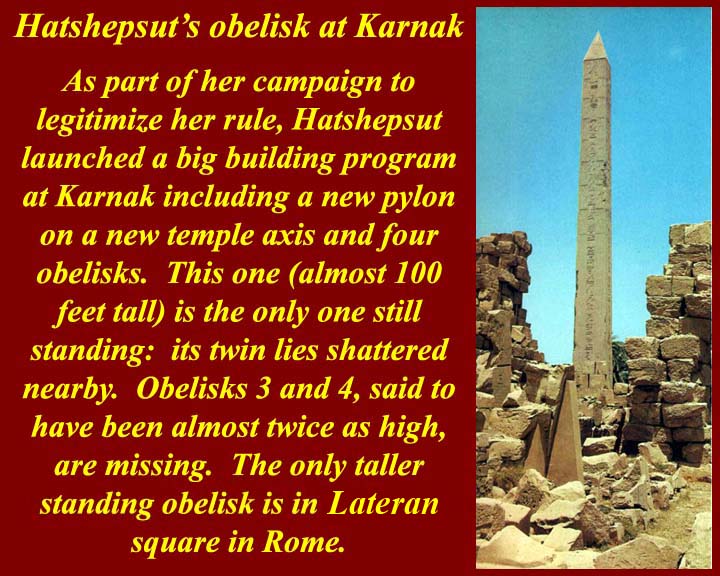
http://www.mmdtkw.org/EGtkw0251bHatshepsutObelisk.jpg
Hatshepsut erected four large obelisks at Karnak, but only this one is still standing. Its 100 foot twin is shattered on the ground nearby. Two much larger ones have gone missing. This one is the second tallest standing obelisk in the world, overtopped only by the one in Lateran square in Rome. Thutmosis III didn't destroy this obelisk, but he did build structures immediately adjacent to it that hid her name. A picture of the taller obelisk in Rome is at http://www.bibliotecapleyades.net/imagenes_vaticano/vatican18_11.jpg, where it, frankly, seems dwarfed by surrounding Vatican Renaissance architecture.
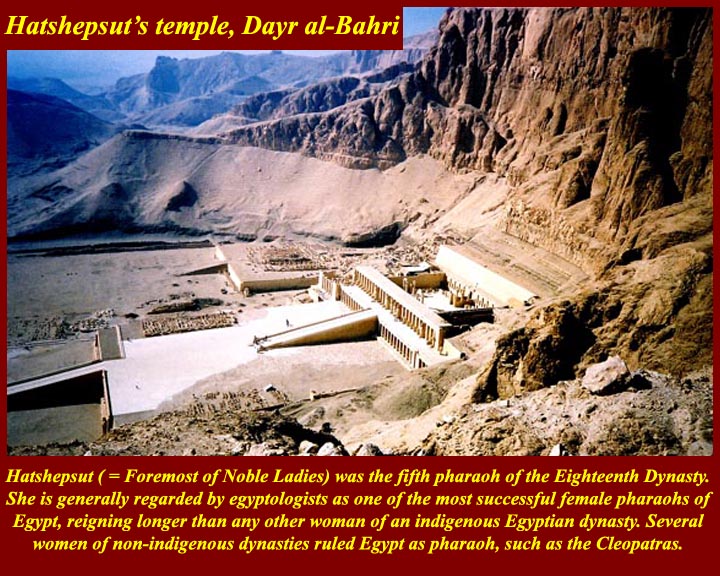
http://www.mmdtkw.org/EGtkw0251cHatshepsutTemple.jpg
Hatshepsut's temple at Dayr al-Bahri is her crowning architectural achievement. It was designed for her by Senenmut, who was her architect and perhaps her lover: there are images of the two of them that show intimacy but not compromise. Her successor, Thutmose III greatly damaged and defaced the temple, but modern archeologists have been restoring it for decades. It's on every tourist's itinerary -- and, because it's a masterpiece, it deserves to be. The temple is not her tomb: that was identified elsewhere, but her body wasn't in it.
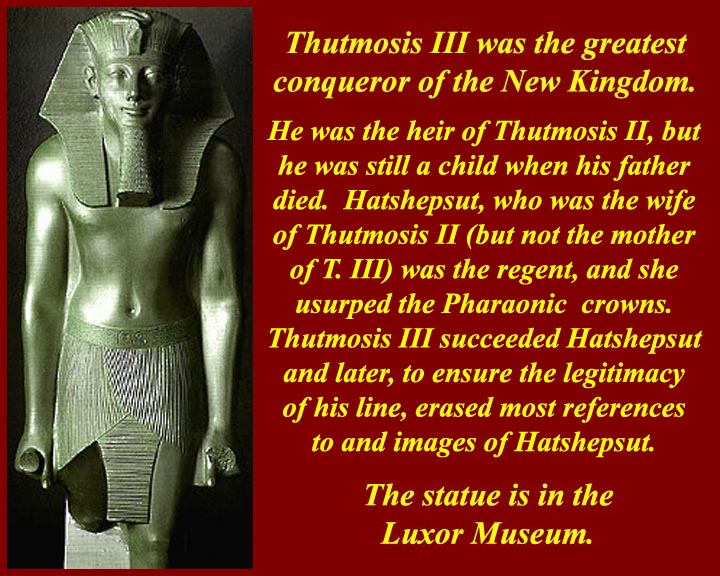
http://www.mmdtkw.org/EGtkw0252ThutmosisIII.jpg
After 22 years of totally subordinate "co-pharaohship", Thutmose became a real pharaoh when Hatshepsut died. He then ruled independently for an additional 32 years. About 20 years into his reign he started his campaign to efface Hatshepsut's name and images. This was not the pique of a long suppressed boy king, but rather was an effort to ensure that his own heirs would inherit.
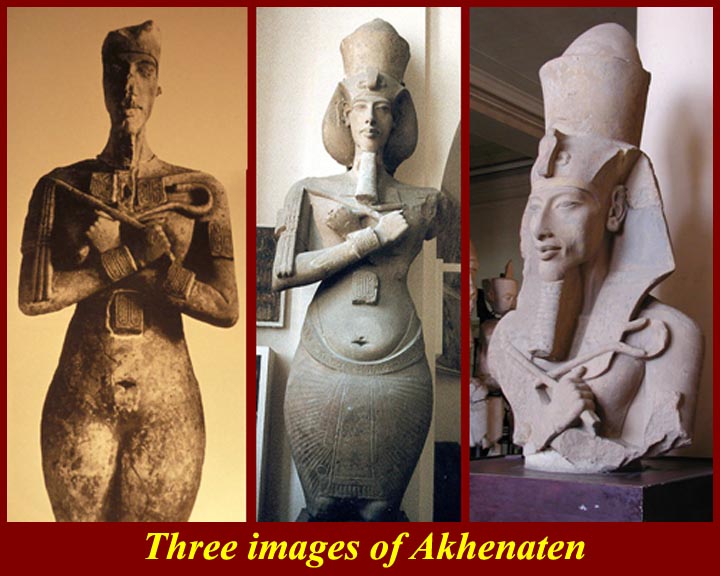
http://www.mmdtkw.org/EGtkw0253Akhenaten.jpg
Akhenatum took the "-atum" off his name and replaced it with "-aten". Aten was the god of the solar disk with whom Akhenaten identified. His new religion was more that just a change of worship to monotheism: he really portrayed himself as a manifestation of Aten. His daily chariot ride from his outlying residence to the administrative palace in the center of his new desert capital, Akhetaten (now called Amarna) was considered to be equivalent to the daily passage of the sun overhead. Aten's temples were open to the sky rather than being a succession of smaller and darker rooms until the cult image was reached in a small totally dark room that only the high priests could enter. In Aten worship, everyone had access to the sun -- and could view the daily chariot-passage of Akhenaten. His wife Neferiti and their seven (or six) daughters were also on public display.
Images of Akhenaten and his family show a refreshing intimacy. The wife and kids are not tiny figures at the feet of the Pharaoh but rather are shown in normal size, kids climbing on the parents as they do. There is, however, a grotesqueness in the bodies and physiognomies of all the family members. This is often attributed to the "Amarna style", but there clearly is some truth the idea that this long-interbred family was congenitally deformed.
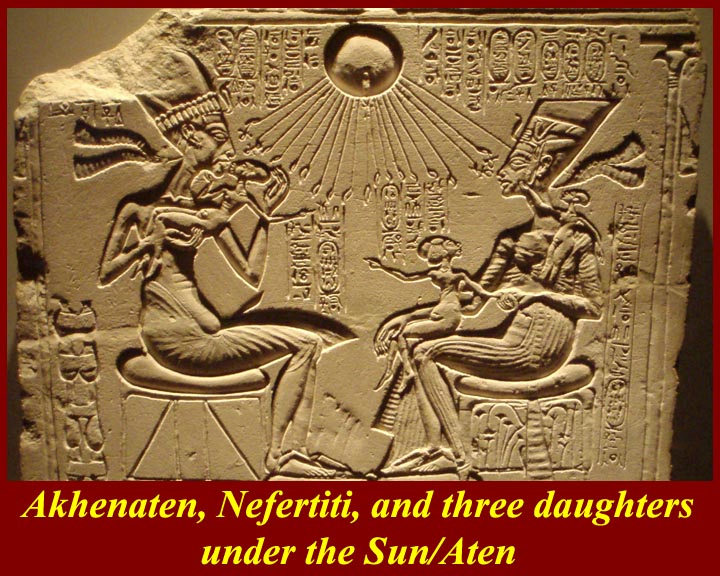
http://www.mmdtkw.org/EGtkw0254HouseAltar-AkhenatenNefertiti.jpg
During the "Amarna Period" household altars (at least in Amarna) to local gods were replaced by altars showing Akhenaten and his family being favored by the Aten solar disk.
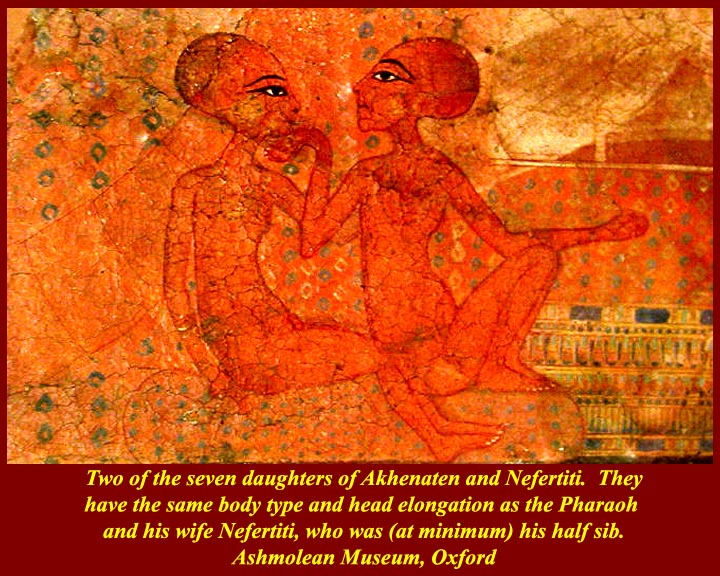
http://www.mmdtkw.org/EGtkw0255AkhenatenDaughtersAshmolean_18.jpg
Two of the daughters of Akhenaten and Nefertiti.
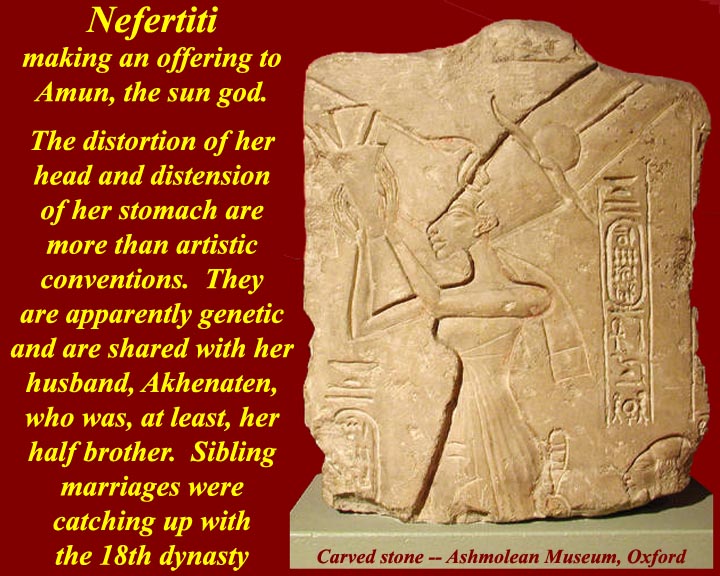
http://www.mmdtkw.org/EGtkw0256NefretitiAshmolean.jpg
Another image of Nefertiti, who was, at least, a half sister of Akhenaten -- some sources say full sister.
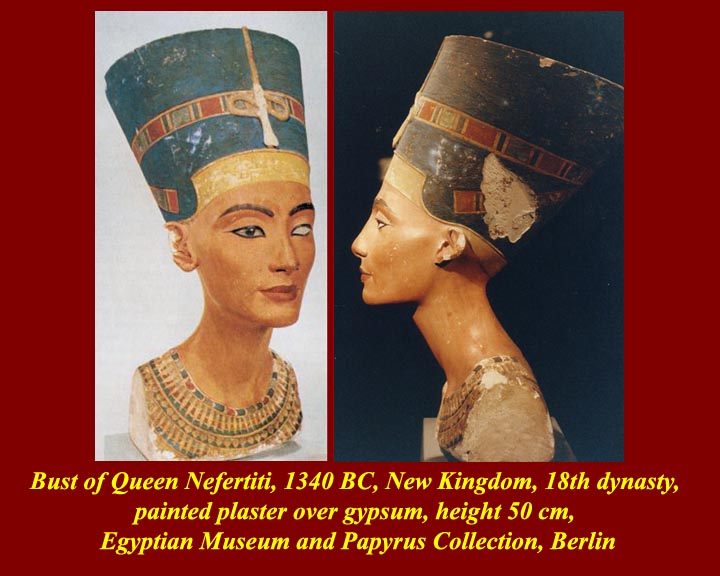
http://www.mmdtkw.org/EGtkw0257Nefertiti1.jpg
The famous bust of Nefertiti, plaster and paint over stone, is still in the Berlin Museum despite Egyptian requests for its return or at least for its loan for display in Egypt. The Germans clearly don't trust the Egyptians to send it back if it ever were sent to Cairo on loan. Said to be the epitome of beauty, but only if you like the emaciated 20th century fashion-model look that sprang from this and other ancient Egyptian skinny images.
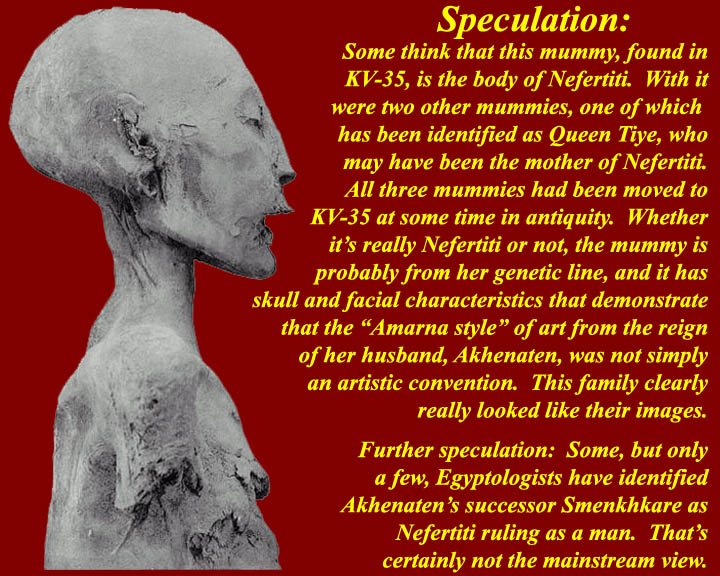
http://www.mmdtkw.org/EGtkw0258Nefertiti2.jpg
The so-called "younger woman" found with the mummy of Queen Tiye, who may have been Nefertiti's mother. Whether or not she's Nefertiti, the family deformation of the skull is clearly present.
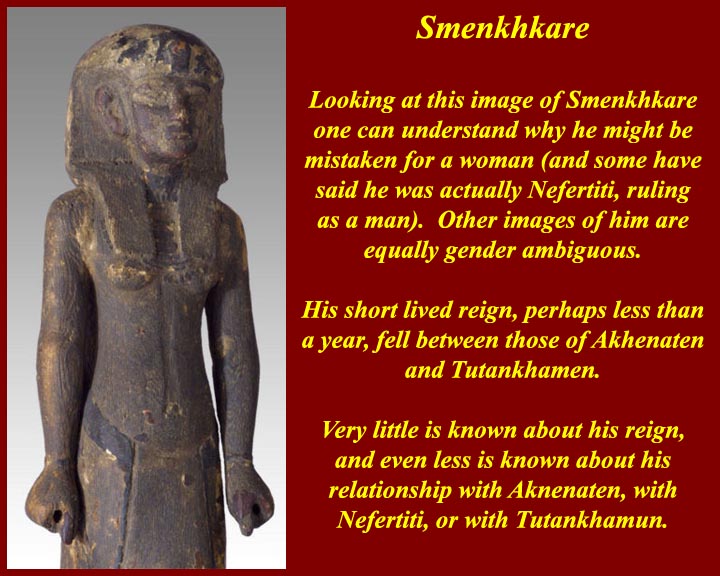
http://www.mmdtkw.org/EGtkw0259Smenkhkare-wood.jpg
A very short-reigning pharaoh, Smenkhkare, about whom little is known, is listed between Akhenaten and Tutankhamun. Images show a feminized "Amarna" body type, and that has led a few Egyptologists to speculate that Smenkhkare was really Nefertiti ruling as a man. The confusion is compounded because Nefertiti and Smenkare have several of their names in common. Most Egyptologists discount this identity speculation, but nobody knows where Smenkhkare came from.
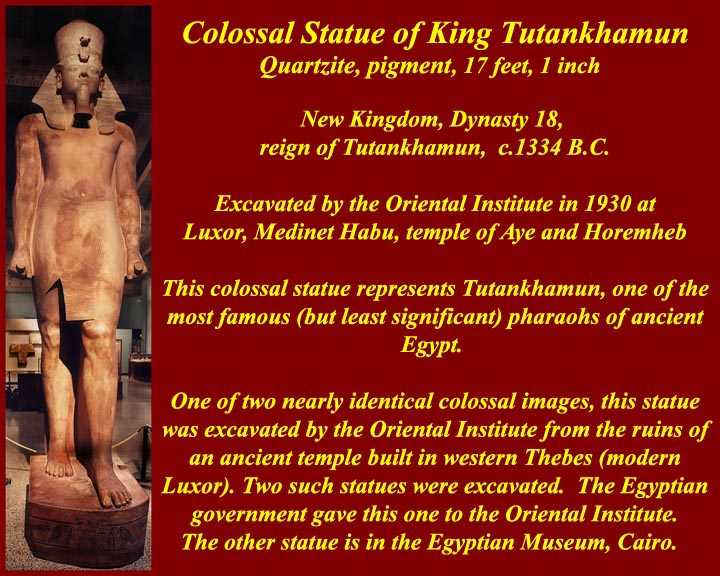
http://www.mmdtkw.org/EGtkw0260Tutankhamun.jpg
Tutankhaten succeeded Smenkhkare and in short order changed his name to Tutankhamun and moved the capital back to Thebes. This quick repudiation of his father's new religion may have been because of agitation among the Theban priestly class and dissatisfaction of the people with radical Aten worship. There was also bound to be confusion and upset due to the quick succession of successions: Akhenaten to Smenkhkare to Tutankaten apparently in the space of a single year. The Theban priests could say that the old gods were angry. Tutankhamun was not the son of Nefertiti, and may not even have been the son of Akhenaten. The new blood apparently did him good, if we can believe his statues. It's also possible, however, that he was portrayed as a "conventional" pharaoh, i.e., that his images followed previous Theban artistic conventions rather than the Amarna style.
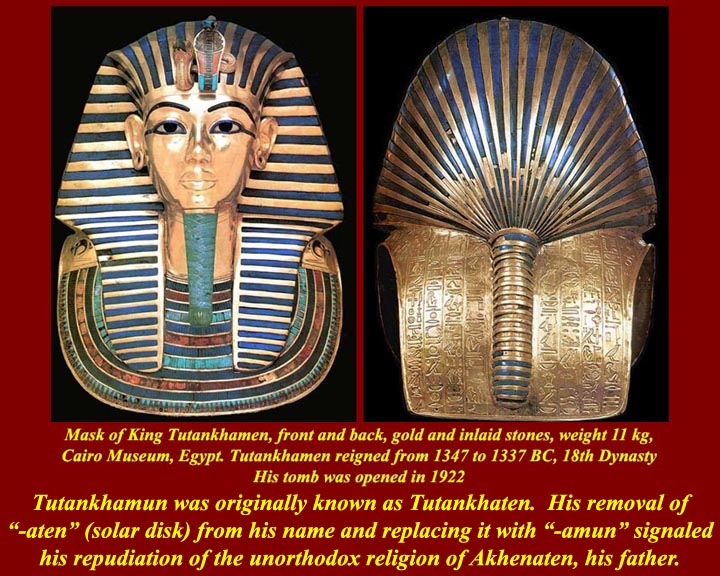
http://www.mmdtkw.org/EGtkw0261TutankhamunMask.jpg
Tutankhamun was really small potatoes as a pharaoh. His main accomplishment, other than succumbing to pressure to repudiate Akhenaten's religion, was being discovered in an undisturbed tomb in the Valley of the Kings in 1922. He had a short and mediocre reign and lived in a time when two moves of the capital would have depleted the treasury. His grave goods were impressive, especially all that gold. But think of what must have been buried in and looted from the tombs of the really big pharaohs.
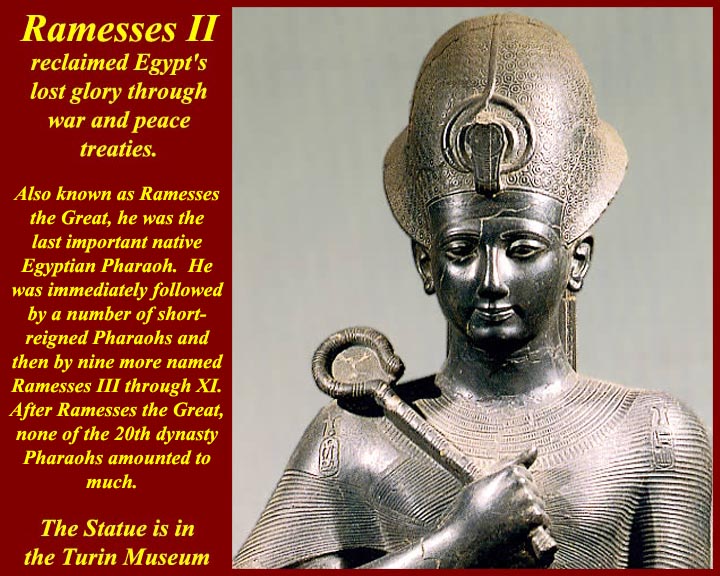
http://www.mmdtkw.org/EGtkw0262RamessesII.jpg
Ramesses II (the Great) was the biggest of the big. His grandiose building programs are still visible from Abu Simbel through the central Theban district and into the Delta. He was successful in war and diplomacy and presided over Egypt for almost 66 years. He is said to have regained Egypt's lost glory and prestige. Unfortunately it didn't survive him. It was all downhill after him.
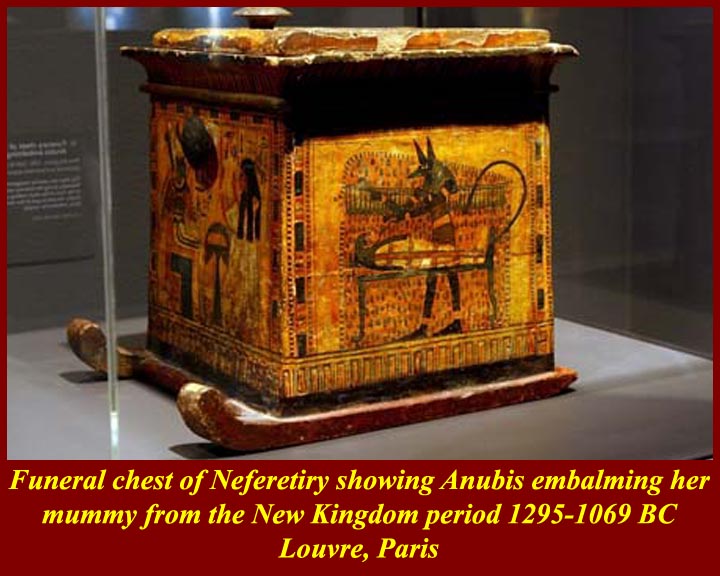
http://www.mmdtkw.org/EGtkw0263NefertiriCanopicChest.jpg
Nefertari's Canopic Chest. Nefertari (Nefertari Merytmut) (c. 1300–1250 BC) was the Great Royal Wife (or principal wife) of Ramesses the Great. Nefertari means Beautiful Companion. She is one of the best known Egyptian queens, along with Cleopatra, Nefertiti, and Hatshepsut. Her lavishly decorated tomb, QV66, is the largest and most spectacular in the Valley of the Queens. By the time of the New Kingdom, Canopic Jars had been replaced by Canopic Chests that had four compartments to hold the viscera of the deceased. They are often mounted on sledges although most of the royal sledges show no sign that they ever were actually dragged anywhere.
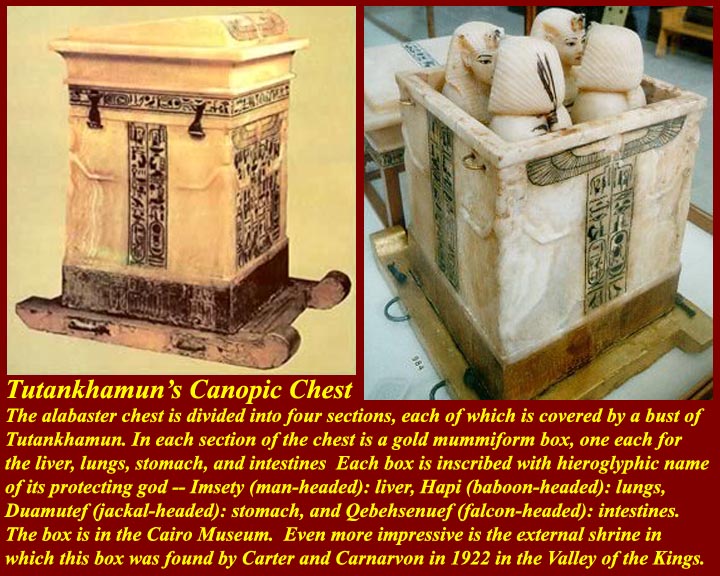
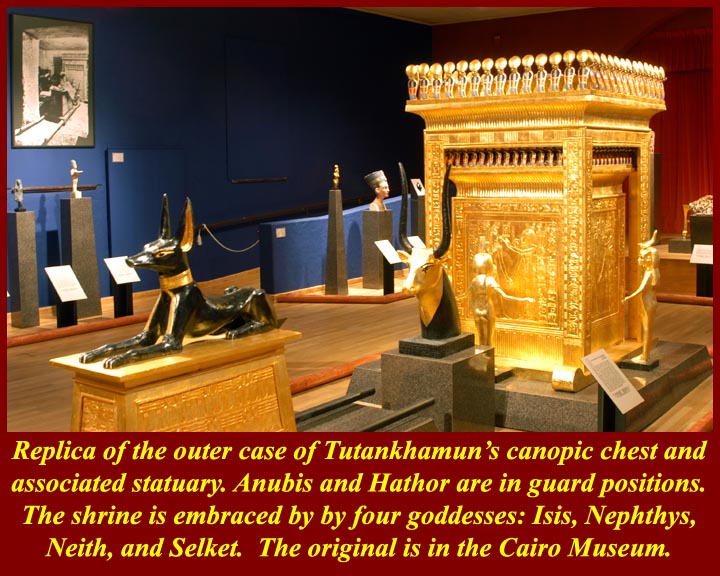
http://www.mmdtkw.org/EGtkw0264TutCanopicBox.jpg
http://www.mmdtkw.org/EGtkw0265TutCanopicShrine.jpg
Tutankhamun's Canopic chest was carved from a block of translucent alabaster, and each of the four compartments had a lid that was carved from alabaster in his image. The chest was enclosed in a golden canopic shrine, a replica of which is shown in the second image. The shrine was in a separate room next to the room in which Tutankhamun was interred.
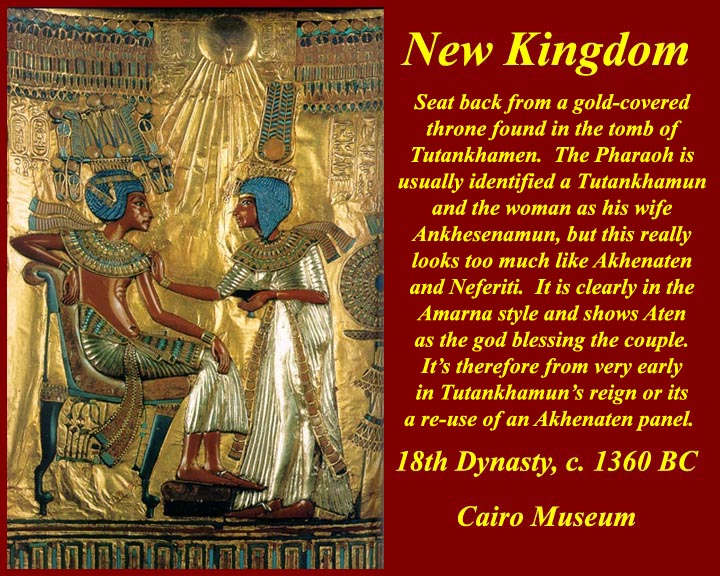
http://www.mmdtkw.org/EGtkw0266TutThrone.jpg
An image of a Pharaoh and his wife receiving the blessing of the Aten is shown of the seat back of the golden throne from Tutankhamun's tomb. The Pharaoh is usually identified as Tutankhamun, but it is in the Amarna style which he had long before repudiated along with the Aten religion. The gold panel may be a re-used one from the time of Akhenaten.
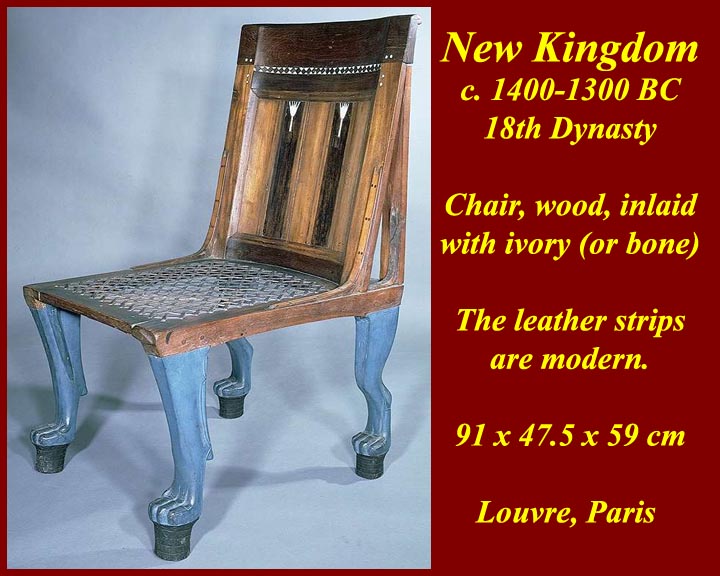
http://www.mmdtkw.org/EGtkw0267NewKingdomChair.jpg
A less ostentatious wooden New Kingdom chair.
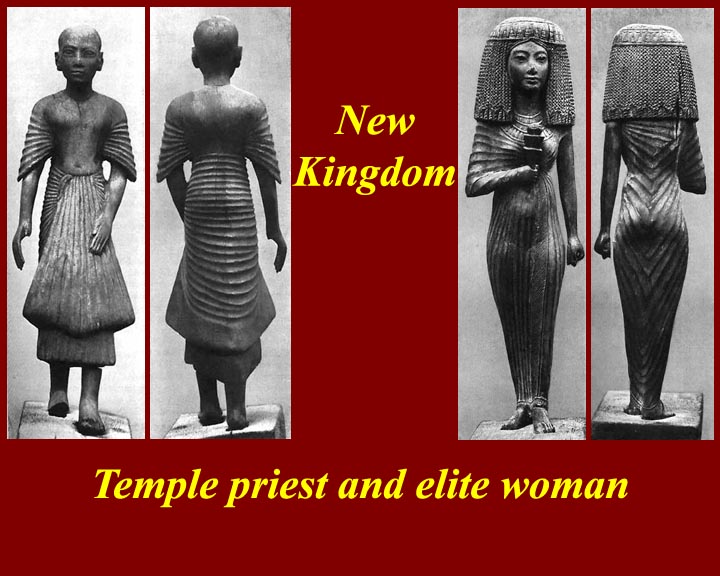
http://www.mmdtkw.org/EGtkw0268NewKingdomCostume.jpg
What did well dressed Egyptians wear to ceremonial occasions? Pleats.
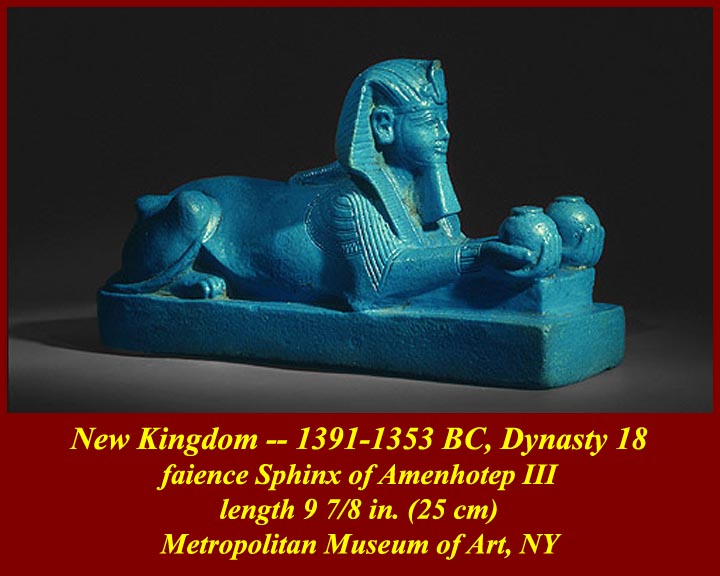
http://www.mmdtkw.org/EGtkw0269NewKingdomFaienceSphinx.jpg
The sphinx remained a popular icon into the New Kingdom and beyond. In fact religious pilgrimages often headed off to Giza to the Great Sphinx. Pharaohs and high officials financed periodic restorations and cleanings (and digging away blowing sand), and affixed dedicatory plaques to the Sphinx and to the walls of the depression in which it stands.
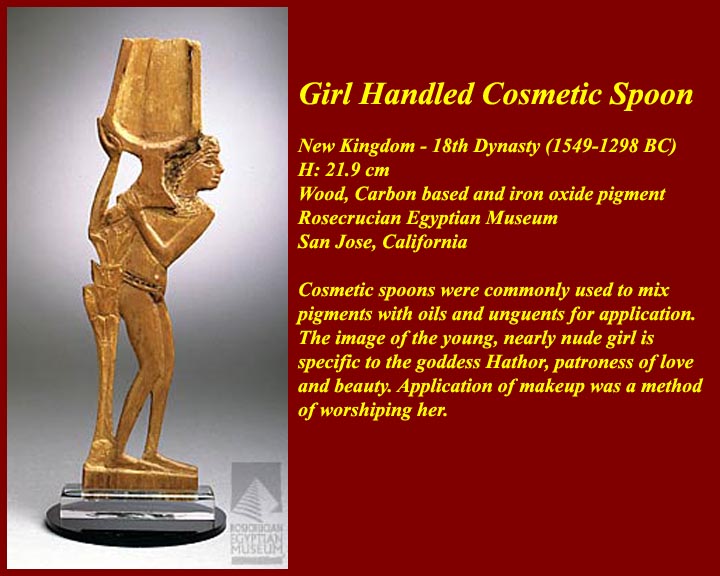
http://www.mmdtkw.org/EGtkw0270CosmtcSpoon.jpg
Cosmetics and beauty were still important both to men and women. The image shows a New Kingdom wooden cosmetic spoon.
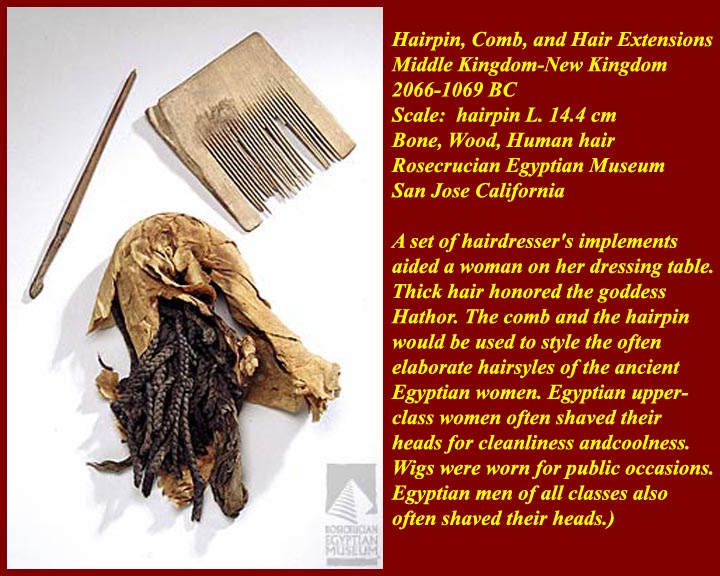
http://www.mmdtkw.org/EGtkw0271WigHair.jpg
Hair and wig care was also a major concern. Wigs and hair extenders were common either because it was cooler and more sanitary to shave heads or because it allowed quick changes of hairstyles. Multiple wigs in wicker boxes have been found in some tombs and storerooms. On the other hand, folks also appear to have been concerned about baldness: the so called Ebers Papyrus (after one of its owners), one of the oldest known medical texts lists several ointments (all disgusting) to cure baldness. For information on the Ebers papyrus, see http://en.wikipedia.org/wiki/Ebers_papyrus.
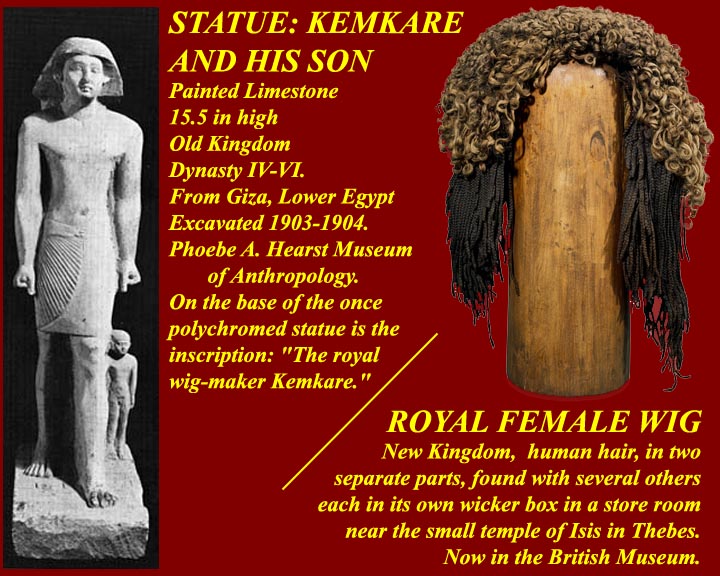
http://www.mmdtkw.org/EGtkw0272WigKemenkare.jpg
Wigs were popular for a long time in ancient Egypt, at least among the upper classes. The image shows an Old Kingdom Royal Wigmaker and a New Kingdom wig.
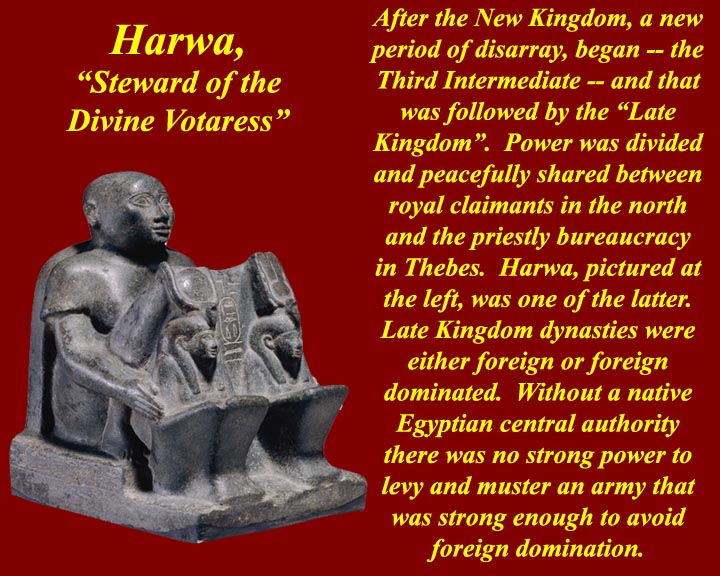
http://www.mmdtkw.org/EGtkw0273Harwa.jpg
Third Intermediate Period. As noted above, things spiraled downward after Ramesses II. After the death of Ramesses XII, the last pharaoh of the 20th Dynasty, rival power structures developed. Priests at Thebes were in competition the greatly weakened pharaohs who moved their capital to Tanis in Lower Egypt. The image is a priestly bureaucrat. Toward the end of the Third Intermediate Period, Libyan influence started to be felt in Lower Egypt.
"Libyans" in those days referred to the autochthonous peoples of North Africa as opposed to Egyptians -- the most closely related group today are the Berbers.
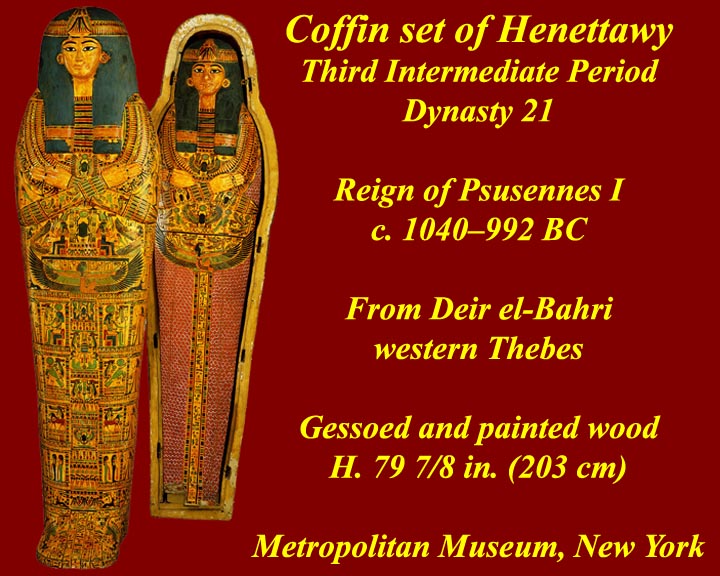
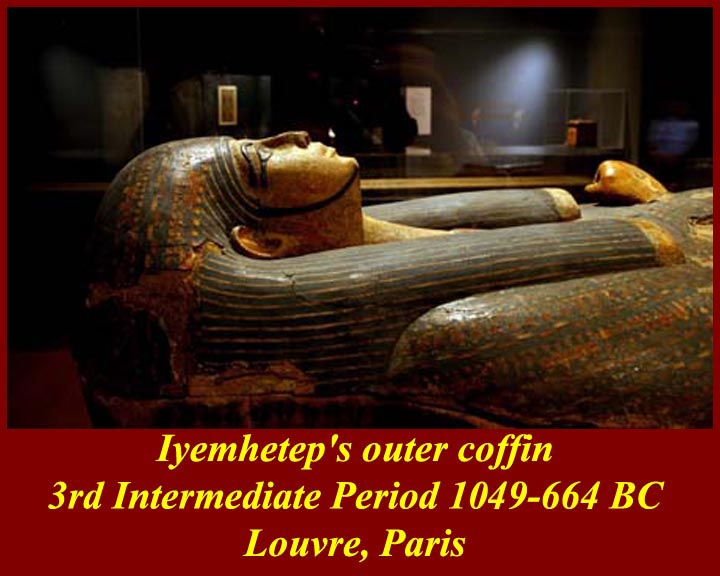
http://www.mmdtkw.org/EGtkw0274CoffinSet.jpg
http://www.mmdtkw.org/EGtkw0275Coffin3rdIntermediate.jpg
Mummification continued. Higher classes got good work (images), and, as always, the lower classes got less than good work.
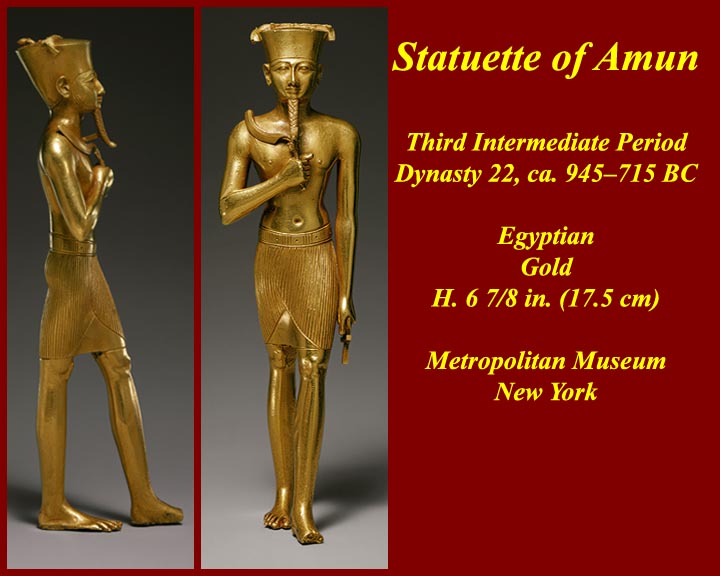
http://www.mmdtkw.org/EGtkw0276Amun22ndDynasty.jpg
Theban gold work continued at a high level. This Intermediate period was not particularly chaotic -- it merely was functioning with two centers.
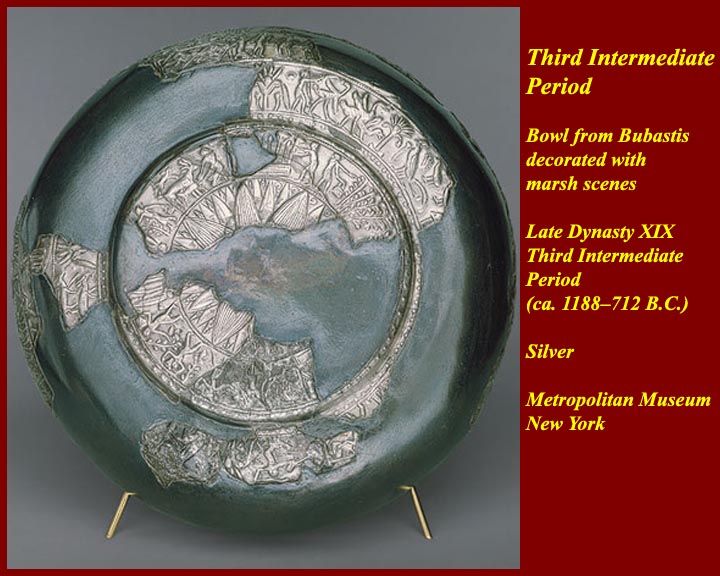
http://www.mmdtkw.org/EGtkw0277BubastisSilverBowl.jpg
Metallurgy was also flourishing in the Delta -- although gold, which came from the south, was more rare. The silver plate is from Bubastis, the cat city.
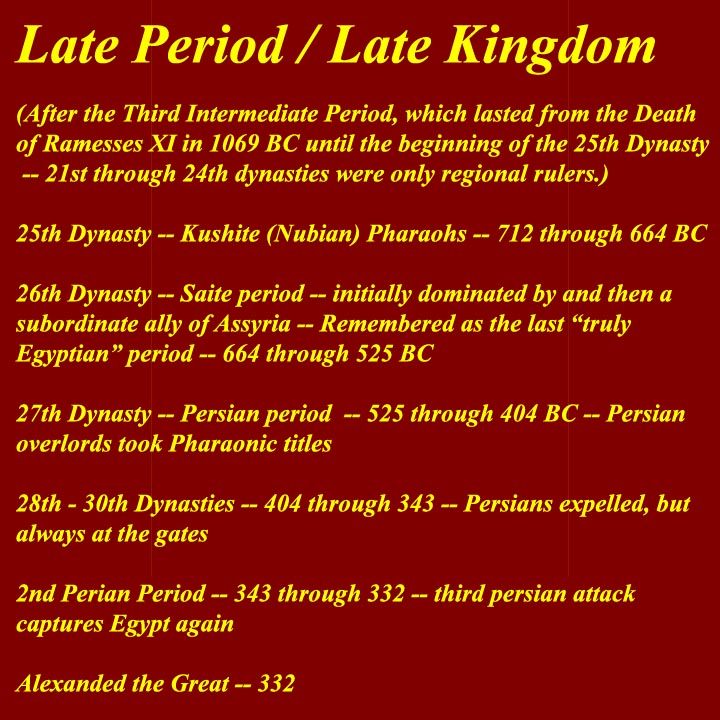
http://www.mmdtkw.org/EGtkw0278LatePeriodChron.jpg
The Third Intermediate Period ended with the expulsion of Libyan influence, but they were expelled by a non-Egyptian Kushite (Nubian) dynasty. From here on out, it;s almost always foreigners in control: Nubians, Assyrians, Persians, and then of course, the Greeks (Ptolemaic Period) and the Romans (after the defeat of Antony and Cleopatra).
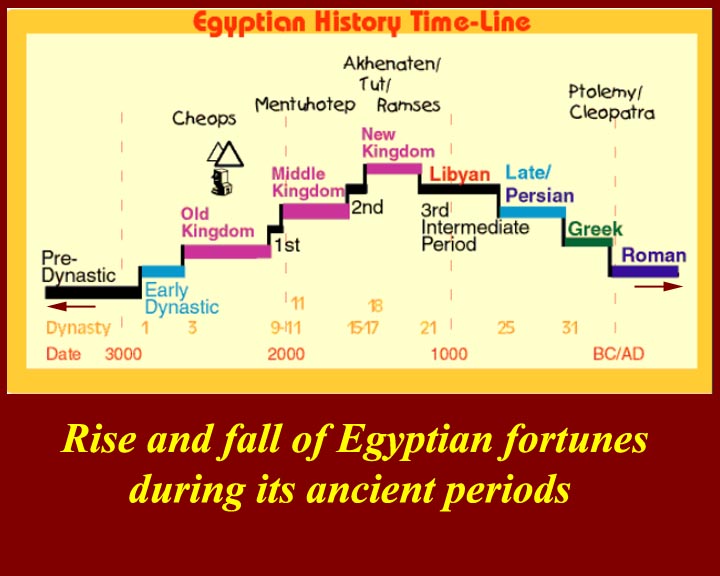
http://www.mmdtkw.org/EGtkw0279EgyptsFortunes.jpg
A graphic showing the rise and fall of ancient Egypt
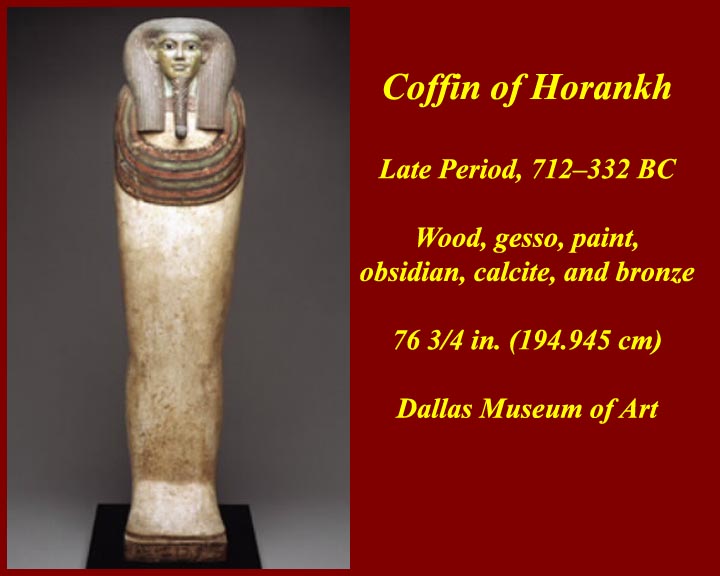
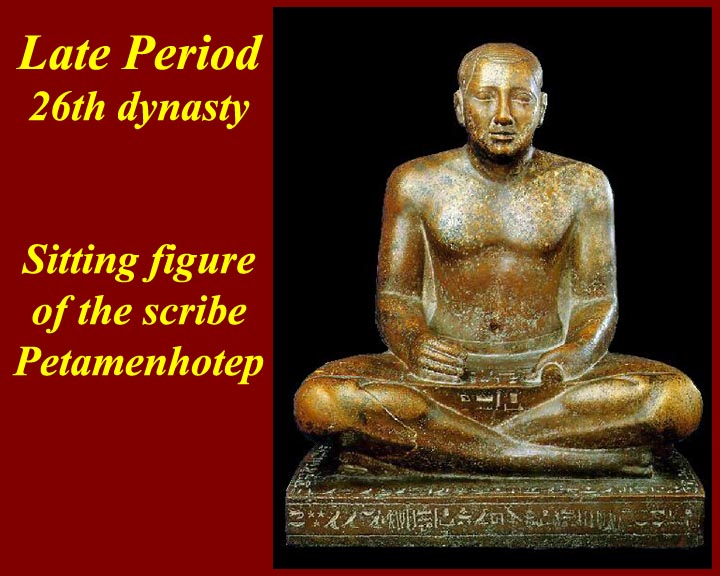
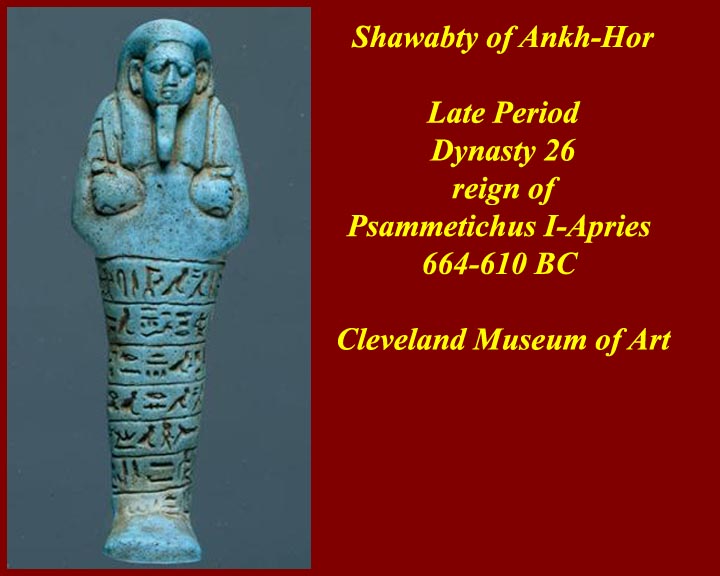
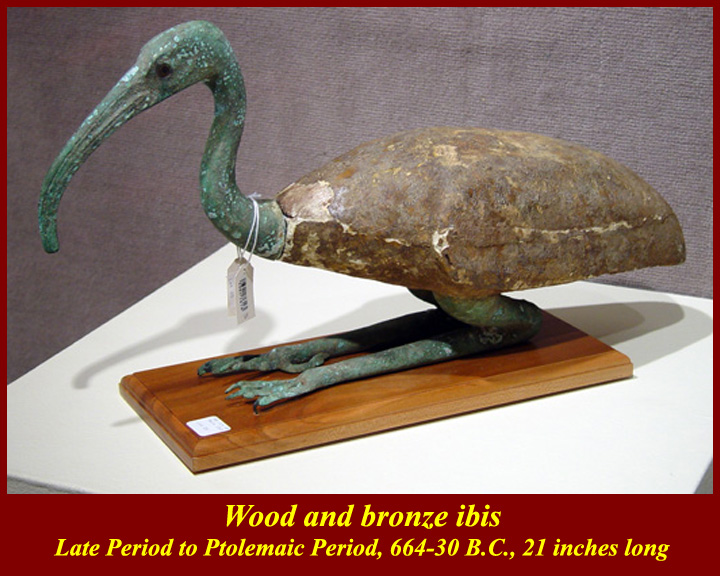
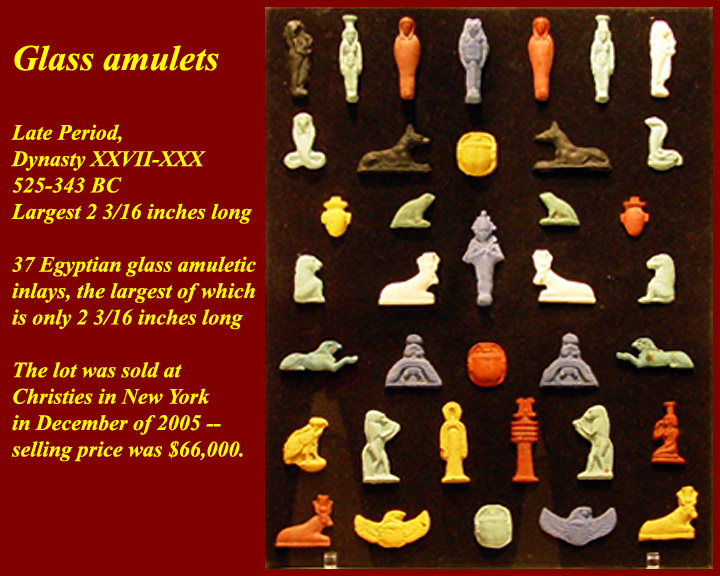
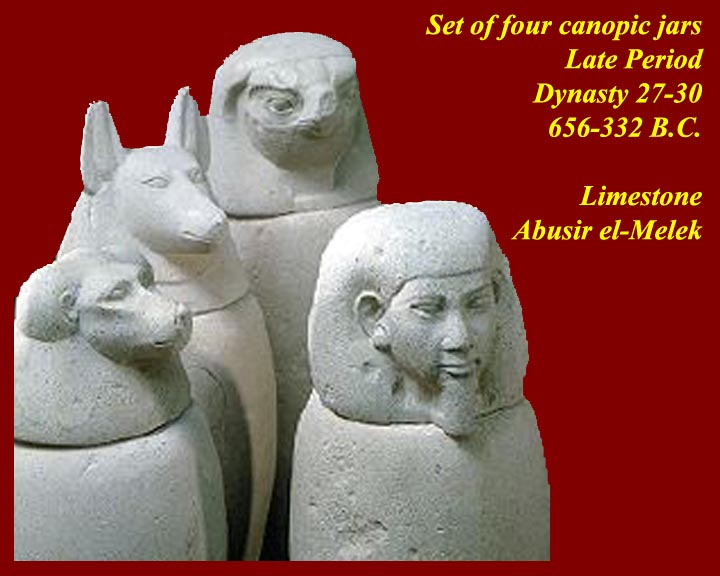
http://www.mmdtkw.org/EGtkw0280LatePeriodCoffin.jpg
http://www.mmdtkw.org/EGtkw0281Petamenhotep_as_a_scribe.jpg
http://www.mmdtkw.org/EGtkw0282Shawabti.jpg
http://www.mmdtkw.org/EGtkw0283BronzeIbis.jpg
http://www.mmdtkw.org/EGtkw0284Amulets.jpg
http://www.mmdtkw.org/EGtkw0285CanopicJarsSet.jpg
Even in the degenerate Late Period, Egypt was more than competitive in the arts. Or at least we have so absorbed the "elegance" of Egyptian art that we consider it to be higher than that in other parts of the world.
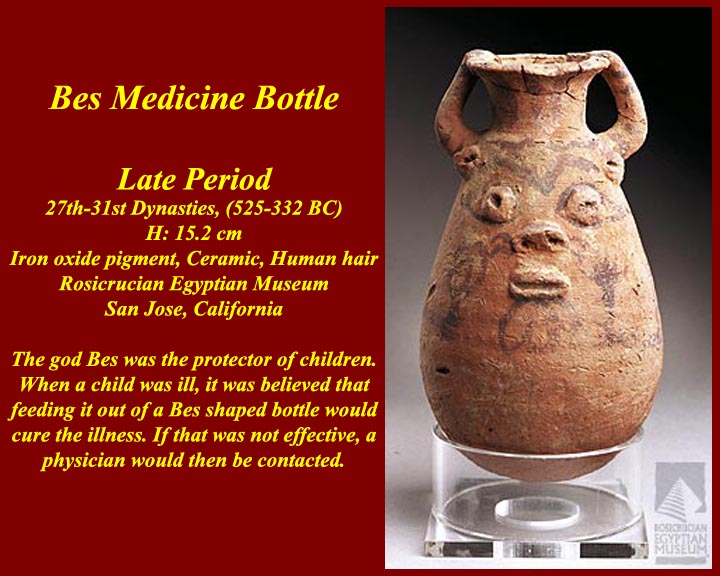
http://www.mmdtkw.org/EGtkw0286BesBottle.jpg
A Bes bottle -- an ill child fed from a Bes bottle should get well. If not, call a doctor.
